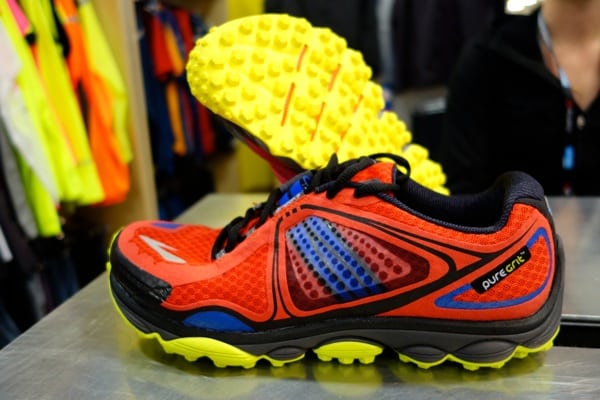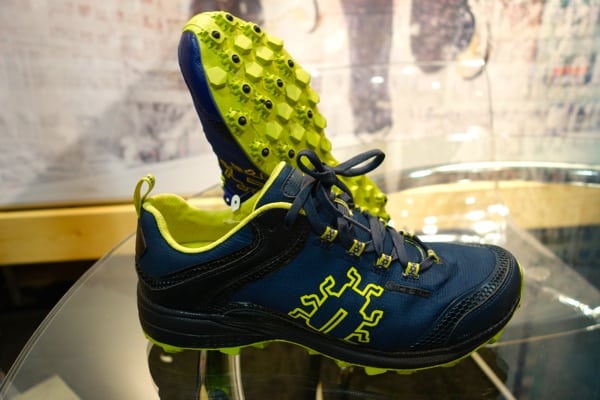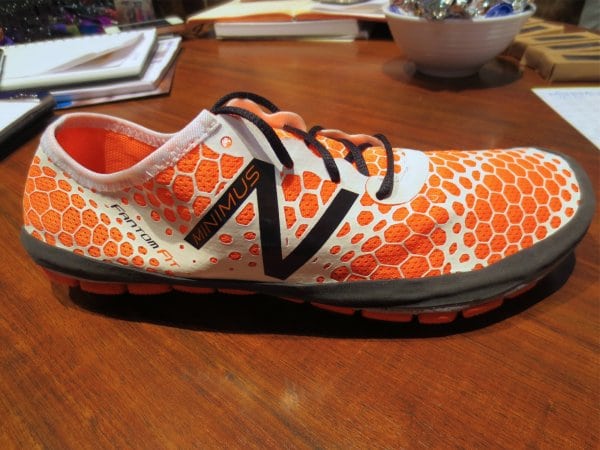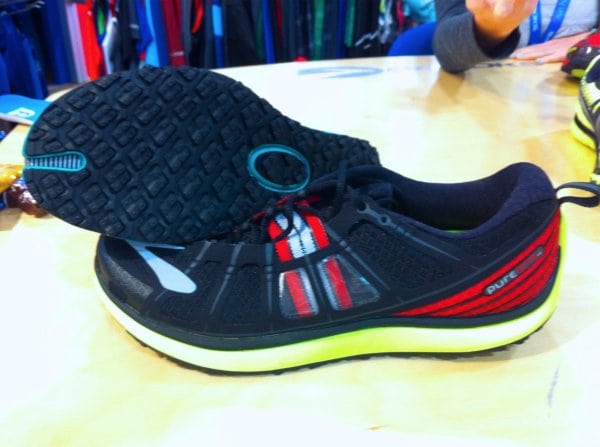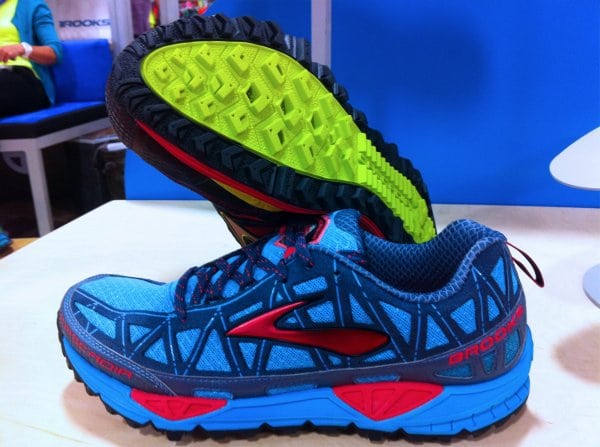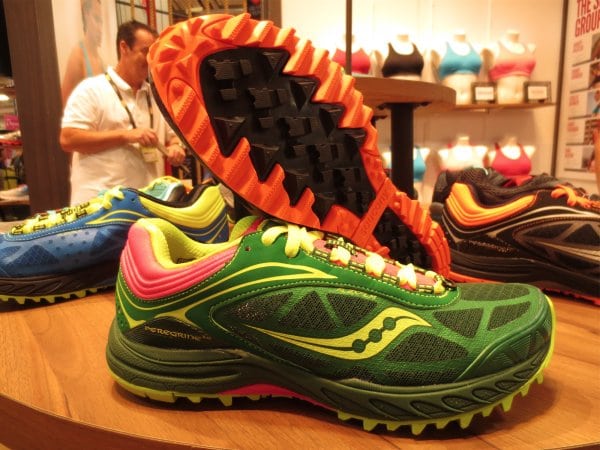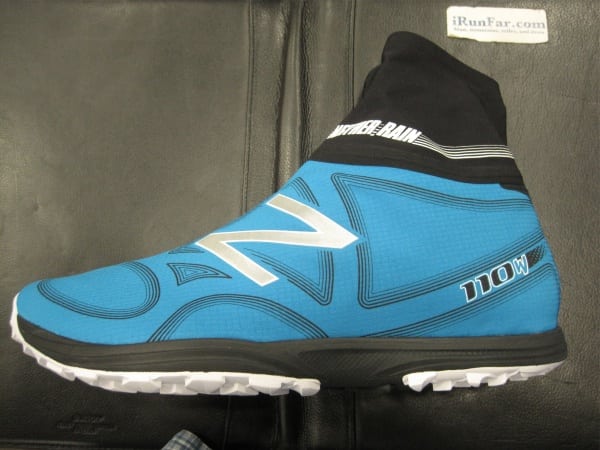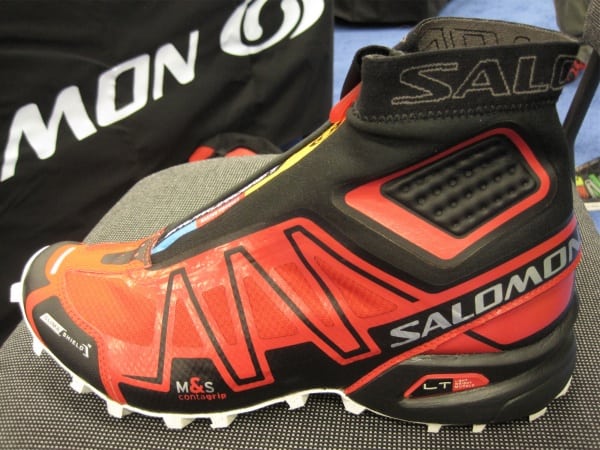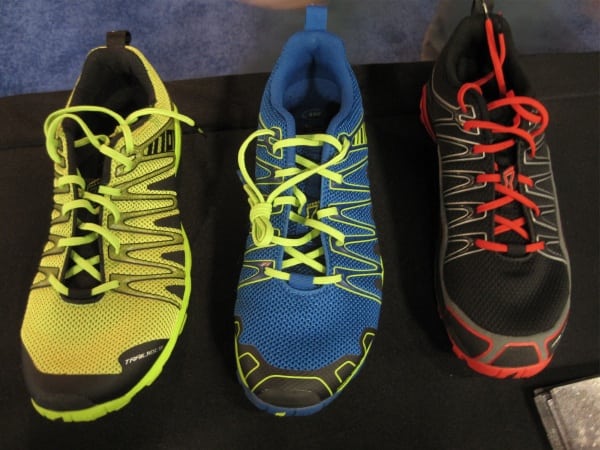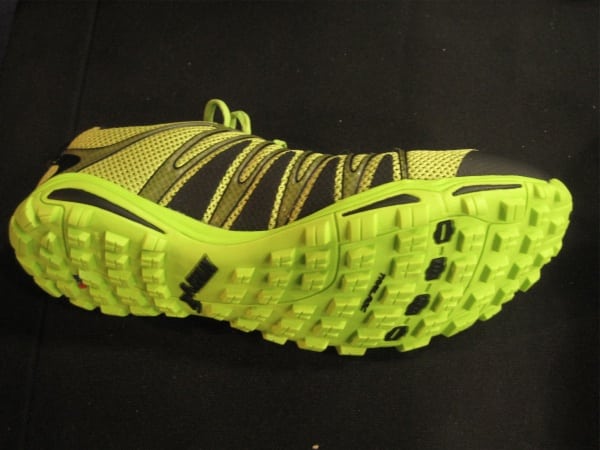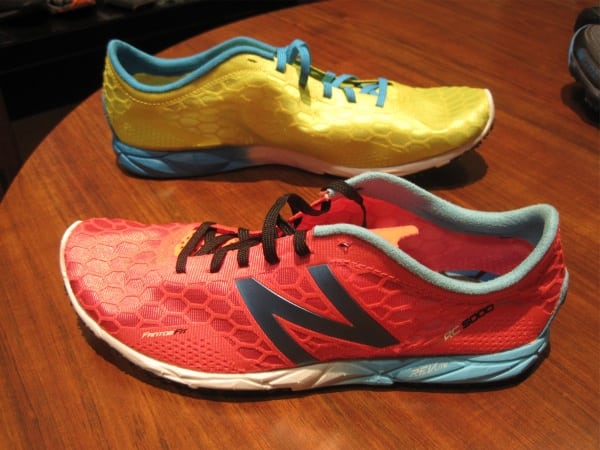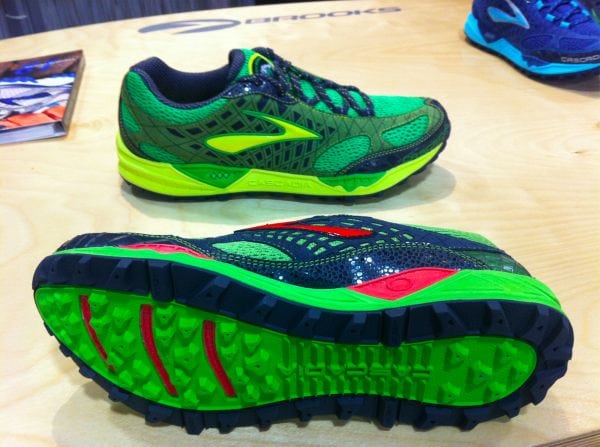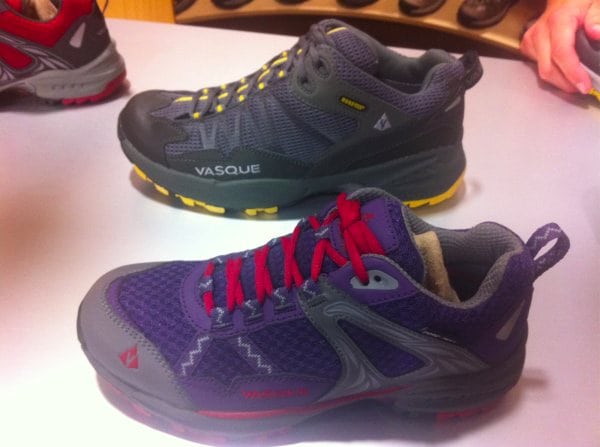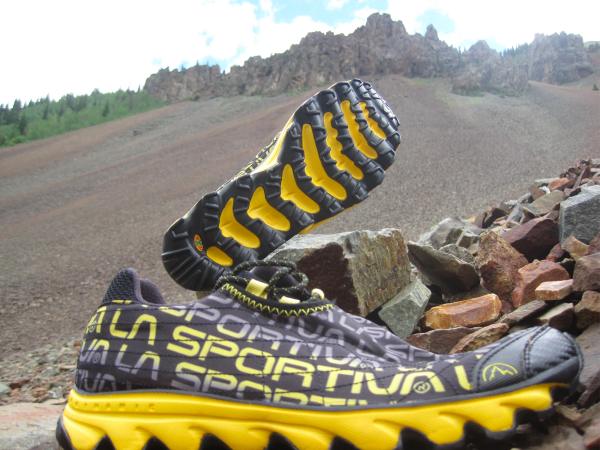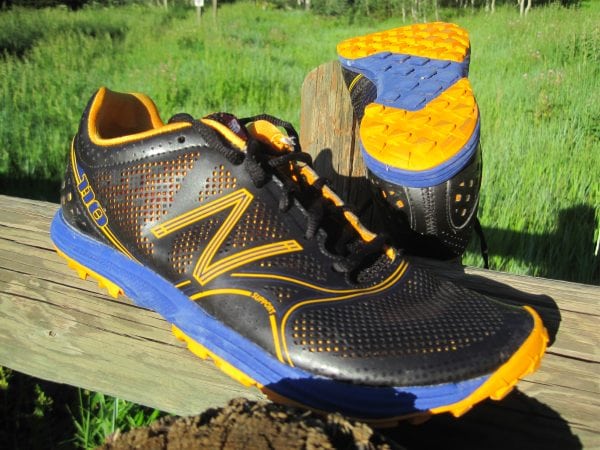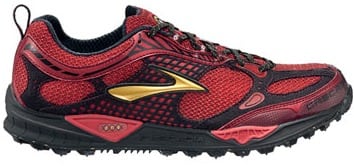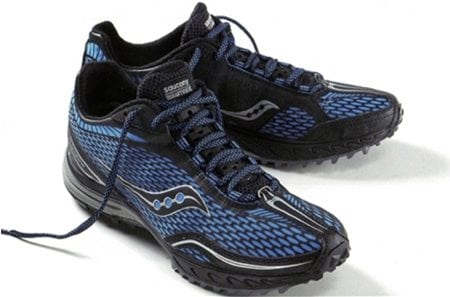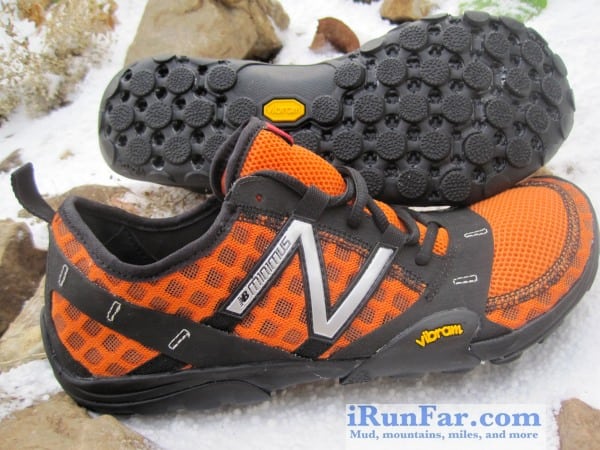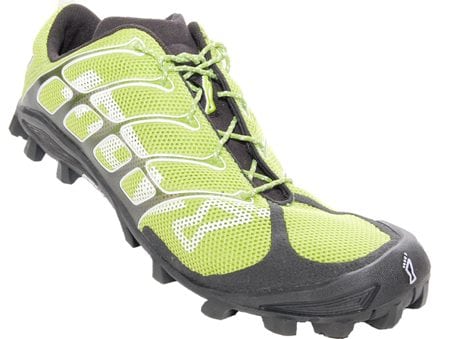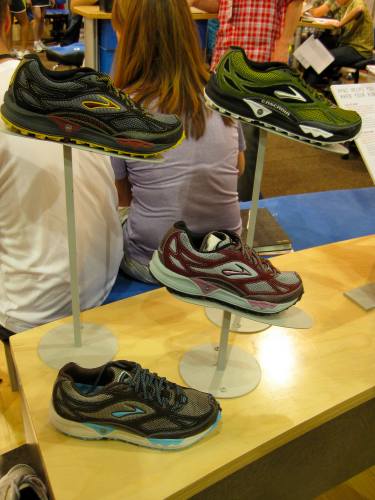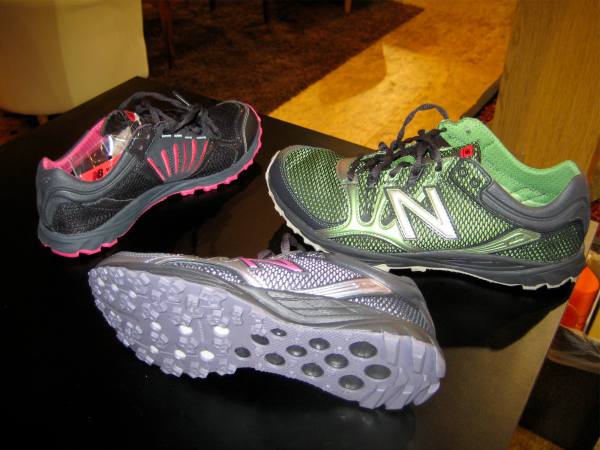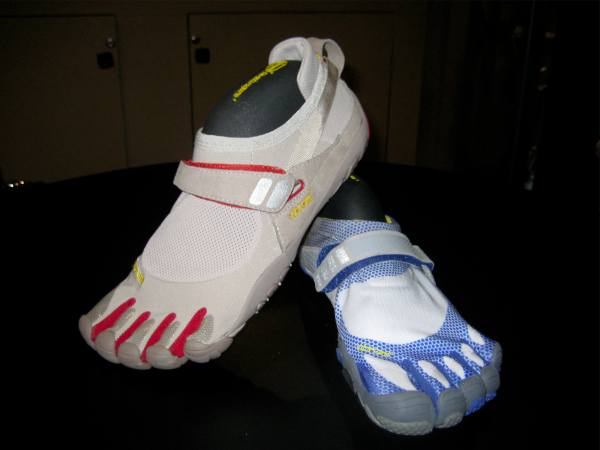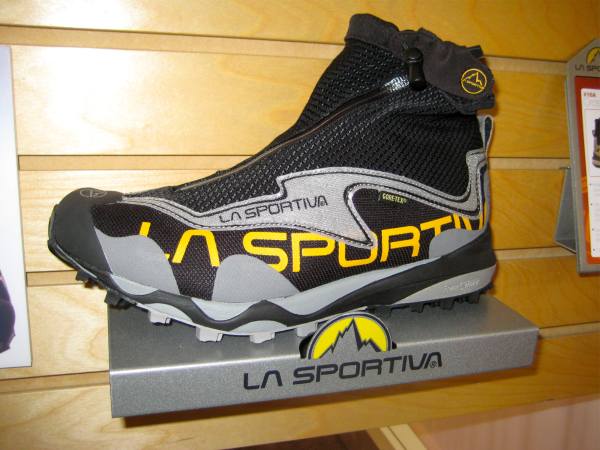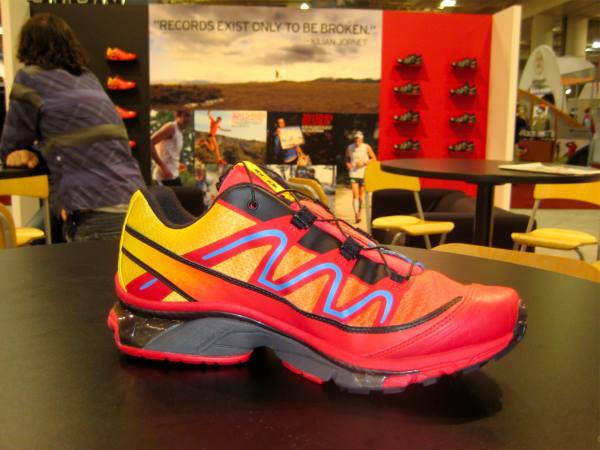What follows is a collection of iRunFar’s semi-annual trail shoe roundups for shoes released from 2009 through 2014. These originally appeared as stand alone articles, but we’ve combined them into a giant trail running shoe archive.
[Editor’s Note: Please know that there are some technical issues with this article, such as broken links, at the moment. We’ll be revising this article in the coming days to help it reach its full potential. Thanks for your patience.]
Best Shoes of Winter Outdoor Retailer 2014
(Originally Published June 21, 2014)
Back in late January, the 2014 Outdoor Retailer Winter Market (i.e., Winter OR) was sneaky. The show floor was quieter than usual (in part due to canceled flights) and there was less trail running buzz than usual, even for the winter version of this semi-annual event. However, in the end, we got to see a surprising number of great new trail shoes. Perhaps, it’s the fact that the wild swings (and accompanying hype) of minimalist and, then, maximalist shoes has calmed down. Now, technologies from the revolutionary products in these classes are being incorporated into more middle-ground products (as well as the products in those categories trending back toward the center). This sounds like stagnation or capitulation, but, perhaps, things gets quieter as you approach perfection.
With releases imminent or having just taken place, look at the hottest trail running shoes of this summer!
- Altra Lone Peak 2.0
- Brooks PureGrit 3
- Hoka One One Mafate Speed
- Icebug AURORA BUGrip
- Inov-8 RaceUltra 290
- La Sportiva Crossover 2.0 GTX
- Merrell Bare Access Trail
- New Balance 980 Trail
- Salomon Fellcross 3
- Saucony Xodus 5.0
- The North Face Ultra Equity
Inov-8 RaceUltra 290 ($140 – June 2014)
With the Inov-8 RaceUltra 290, the company is launching an entirely new platform, one specifically with ultrarunning in mind. For one, the outsole flatter and, perhaps, wider than more Inov-8 models in an attempt to increase stability. The shoe uses the Trailoc 255’s full-foot Meta-Shank III. However, an extra 2-4 millimeters of stack height provides a bit more protection in the RaceUltras than the Trailrocs. The breathable mesh upper should be great hot conditions. The shoe is a two-arrow shoe, meaning expect a 6mm drop under Inov-8s convention, but the RaceUltra 290 has a 8mm drop. The outsole is well, but not obnoxiously lugged–presumably more than enough for all but special scenarios. There’s also a proprietary gaiter attachment system.
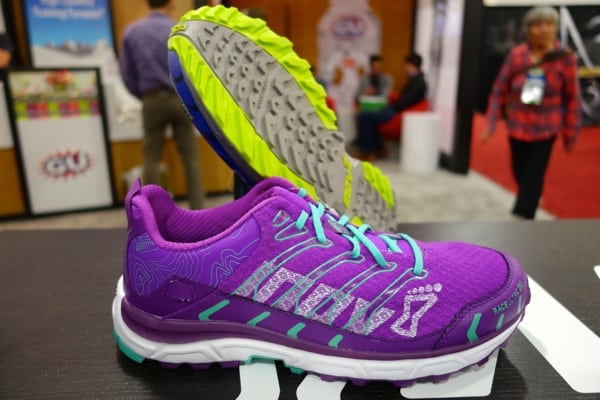
Brooks PureGrit 3 ($120 – June 2014)
Of the upgrades seen to existing shoe models at this OR, none were as radical as the changes seen in the Brooks GurePrit 3. Yes, the PureGrit 3 stays true to the Pure Project with its rounded heel, navband, and 4mm drop. However, the shoe starts to look at bit more like a traditional trail shoe with the removal of the toe-flex groove and midfoot underfoot pod as well as the addition of more aggressive lugging and a beefier toe bumper. At first glance, it just looks more like a trail shoe than the somewhat unfamiliar aesthetic of the PureGrit and PureGrit 2. The shoe will come in at just under 10 ounces (9.9).
Altra Lone Peak 2.0 ($120 – July 1, 2014)
At this point, Altra is overhauling each of its models every other year. This OR, it’s the Altra Lone Peak 2.0 that makes a break from it’s predecessor, the Lone Peak 1.5. First off, the upper is unrecognizably different. Gone are the iconic mountain overlays. Heck, gone are pretty much all the substantial overlays in favor of mesh with film overlays currently most visible in Pearl Izumi’s E:Motion lineup. To keep the midfoot snug, Altra has added a wrap up the outer mesh.
For many, the Lone Peak and LP 1.5 were already fairly plush and protective, but Altra’s gone and bumped both those aspects up in the 2.0. To start, there’s an extra 2mm of cushion throughout the midsole. Next, Altra added a second rockplate–just 1-cm wide–along the lateral arch for some additional metarsal protection This all means that the shoe is a touch heavier. It’ll weigh in at 10.3-.4 ounces.
In case you think Altra completely scrapped things, that’s not the case. Iconic features such as the rear trail rudder and the gaiter trap remain. (See our forthcoming non-shoe winter OR ’14 article for more on the gaiter.)

Other Debut from Altra:
- Altra Lone Peak 2.0 Polartec ($145 – September 2014) – For next winter, Altra will be releasing the first ever Polartec Neoshell running shoe. It’ll weigh in at about 11 ounces.
Hoka One One Mafate Speed ($170 – July 1, 2014)
With some many new Hoka models being debuted and nearly all of the company’s “road” models being heavily used on the trails, it’s hard to pick one model on which to focus. In the end, I’ve chosen a major update to the shoe that started it all–the Mafate. The biggest change with the Hoka One One Mafate Speed, at least in terms of feel, is the replacement of the previous midsole material with Hoka’s high-round RMAT material. The outsole is also all-new with narrower platform that the previous Mafates. The Mafate Speed sits at 12.0 ounces (compared to the Mafate 3’s 14.7 ounces) and stands 31-35mm tall. Plenty of shoe for the beefiest of trails.

Other Debuts from Hoka One One:
- Hoka One One Clifton ($130 – July 15, 2014) – According to Hoka, the Clifton is “superminimal”… and it is, well, for a Hoka. The upper is stripped down, it sits half a centimeter closer to the ground than the Bondi 3, and weighs only 7.9 ounces (225 grams). The Clifton features midsole channeling (like in the recently released Conquest) for flexibility.
- Hoka One One Huaka ($150 – July 15, 2014) – Having run in the Huaka, personally, this is my favorite Hoka model ever. The RMAT midsole, early-stage Meta Rocker, and slight bit of flexibility underfoot make the ride plush, but not controlling. It’s the second lowest-to-the-ground Hoka, but I find it feels even lower than the Rapa Nui 2.

Hoka One One Huaka
The North Face Ultra Equity ($115 – July 15, 2014)
With The North Face Ultra Equity, the company has a more than capable shoe for the ultrarunning masses. The North Face labels this a “stability” shoe, but that’d be “stability” under the new paradigm. This is a nimble-enough, 10.6-ounce (300 gram) shoe. I’ve yet to find the construction at all restrictive, rather the shoe’s structure feels enabling. Its upper, which combines a highly-breathable mesh with TNF’s Flashdry, is extremely comfortable.
Icebug AURORA BUGrip ($180 – September 1, 2014)
Tired of heavy combinations of your normal running shoes and traction devices, well maybe it’s time to give Icebug a look. The company, which made its name in orienteering footwear, isn’t new, but its product remain relatively unknown in the States. With the Icebug AURORA BUGrip, the company is offering a 9.2-ounce (260 gram), selectively water-resistant (it’s waterproof up to the eyelets) shoe with 19 carbide tips built into each sticky-rubber outsole. This should let you run fast and confident on nearly any surface. The AURORA has an 8-mm drop.
La Sportiva Crossover 2.0 GTX ($175 – August 2014)
While not a style needed for everyone’s trail running, the integrated-gaiter waterproof/resistant trail shoe fills a need for some who live in snowy climes. Apparently, La Sportiva has seen enough demand and/or promise in this concept to offer a revision of the Crossover a few years after its initial release. The La Sportiva Crossover 2.0 GTX is a 13.1-ounce (370 gram) winter version of the C-Lite. It’s built on the C-Lite (formerly C-Lite 2.0) platform, but with a slightly softer midsole.
In addition to changing the foundational shoe to the C-Lite 2.0, La Sportiva made three significant upgrades from the original Crossover. First, the gaiter is softer and more flexible, reducing the chance of discomfort and chafing around the ankle. Second, La Sportiva has designed the gaiter to make the underlying laces more accessible. This is a major improvement in allowing customized fit. Third, the shoe now incorporates GORE-FLEX in the waterproof booty, allowing for more comfort, especially in the forefoot.
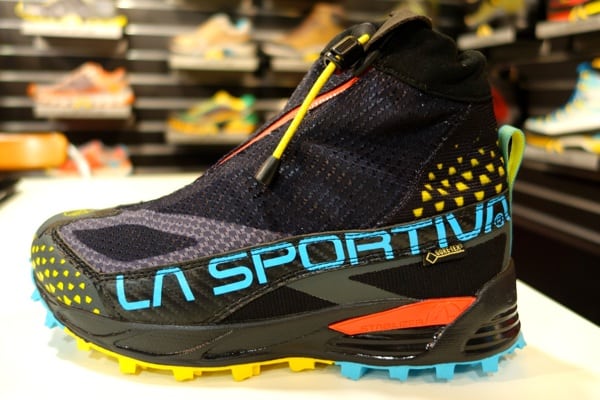
Other Debut from La Sportiva:
- La Sportiva Ultra Raptor GTX ($175 – August 2014) – A GORE-TEX version of the Ultra Raptor. Weighs in at 14.5 ounces (410 grams). It, like the rest of the of the La Sportiva running line, now come with Ortholite insoles.
Salomon Fellcross 3 ($170 – July 15, 2014)
In its latest version, the Salomon Fellcross 3 is even better suited to muddy conditions as the foam has been changed to a more hydrophobic version. As a result, the shoes should stay svelter in swampy scenarios. Other than that, it remains a low-riding, mud-shredding machine.
New Balance 980 Trail ($110 – July 2014)
So, if you read road running mags or are otherwise plugged into the road running world, chances are you’ve heard of New Balance’s new Fresh Foam. Well, it’ll come to the trails for the first time this summer in the form of the New Balance 980 Trail. The trail version of the 980 will have smaller lugs than the road version as well as have additional uphill-/downhill-oriented grip. The upper will also feature more reinforcement and a more closed mesh. There’s no rockplate and a 4mm drop in this 10.25-ounce shoe.
Merrell Bare Access Trail ($100 – May 15, 2014)
The Merrell Bare Access Trail and its Bare Access counterparts sit between Merrell’s well-known Glove running line and more cushioned, more protect AllOut line. With the Bare Access Trail, you’ll be getting a flexible, low-to-the-ground (0mm drop, 4mm lugs, 8mm midsole, 15.5mm stack height) trail shoe in an 8.3-ounce (235 gram) package. There’s no rockplate in the Bare Access Trail, but there is a full-coverage outsole and slightly firmer midsole foam for protection. There are heel pods for lockdown and wide forefoot. The footbed is non-removable.
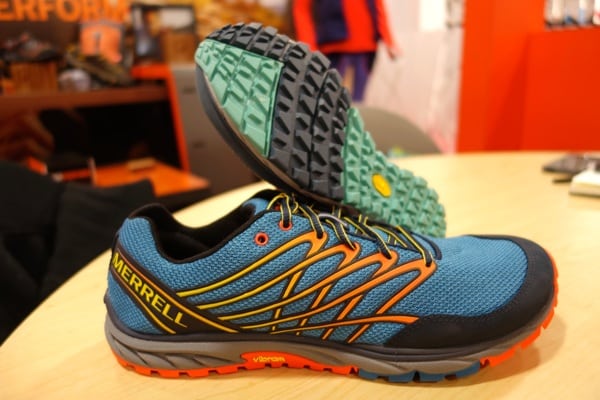
Other Debuts from Merrell:
- Merrell Bare Access Ultra ($100 – May 15, 2014) – More of a road shoe, but suitable for the trails. The midsole is softer and higher rebound than the trail version. It’s lighter at 7.0 ounces (200 grams) with zero drop and 12mm midsole (17mm stack height).
- Merrell AllOut Flash ($110 – May 15, 2014) – A 6.3-ounce (180 gram) road shoe with a 6mm drop and 14mm of midsole.

Merrell Bare Access Ultra
Saucony Xodus 5.0 ($120 – August 1, 2014; GTX for $140)
In its fifth iteration, the Saucony Xodus 5.0 is the first Xodus to go under 11 ounces at 10.7 ounces (300 grams). At the same time, the outsole’s been made more aggressive, including an extra millimeter of lugging. It’ll also be made of a stickier rubber compound come August. One place where weight savings were found is in the stripped down upper. For those looking for trail features like a gusseted tongue, lace pocket, or gaiter trap, the Xodus 5.0 has ’em.

Call for Comments
- Which new shoe models have you most excited?
- What will you be hitting the trails in this summer?
- Have any questions? Ask away!
Best Trail Running Shoes of Outdoor Retailer Summer 2013
(Originally published August 8, 2013)
It’s the beginning of another August and that means it’s time for our roundup of the best new shoes of this summer’s Outdoor Retailer show, where companies highlighted their spring/summer 2014 offerings, which will generally debut in the first two months of next year. For the most part, this year’s show was full of incremental rather than revolutionary change.
Click on any of the following featured shoes to jump down to our preview of the model. If you don’t find what you’re looking for on this list, try searching this page as we provide abbreviated previews on a number of other models. We’ve also published a Facebook album with additional angles and models.
- Altra Olympus
- ASICS Fuji Racer 3
- Brooks Cascadia 9
- Dynafit Pantera
- Hoka One One Conquest
- La Sportiva Bushido
- Merrell AllOut Rush and Fuse
- Montrail FluidFeel II and FluidFlex II
- New Balance 110v2
- Patagonia EVERlong
- Salomon S-Lab Sense 3 Ultra SG
- Saucony Peregrine 4
- SCARPA TRU
- The North Face Ultra Trail
- Vasque Ultra SST (née Shapeshifter Ultra)
- Vibram Vybrid
Hoka One One Conquest ($170 – January 1, 2014)
The Hoka One One Conquest is going to be one of those shoes that we have to run in before forming an opinion. Why? Because it looks ridiculous, BUT so did the original Hoka concept and it’s worked out well. So what’s going on with the Conquest? Two main things – Rmat and a truss system.
Rmat is a new midsole material proprietary to Deckers, Hoka’s new parent company. It’s an injectable natural rubber with high weight-to-resiliency properties resulting in greater midsole durabilty and an even more silent ride. The Rmat layer is overlaid with Hoka’s proprietary EVA to maintain the Hoka feel underfoot.
Unlike the traditional use of a truss in footwear, the Conquest’s truss isn’t there to add support. Rather, the truss is there to allow decoupling in the rear of the shoe upon heel strike. The truss and a deep foot frame in the heel make the Conquest look like it rides higher off the ground than it really does. The shoe incorporates water drainage ports.

Hoka One One Conquest
Other updates from Hoka:
Rapa Nui 2 ($130 – January 1, 2014) – While the original Rapa Nui was never released in the US, the Rapa Nui 2 will make it over to the States in a limited release late this year before a full launch at the start of next year. The shoe has been updated with a no-sew upper that provides a more streamlined fit.
Bondi B 3 ($150 – January 1, 2014) – The third version of the Bondi B will keep the same midsole/outsole while the upper switches to a seam-free interior to the upper that’s more flexible, more breathable, and subject to high QA standards. The tongue will be thinner and lighter, while the midfoot has been snugged up a bit.
In addition, aside from the Kailua, all Hoka’s women’s models will switch to a women’s last with January 1 releases.
New Balance 110 v2 (Price TBD – July 2014)
Next year’s revision to the New Balance 110, the 110 v2, will offer a lot more underfoot and dumb down the 110 to the basics. There’ll be a full rockplate. There’ll be a full-coverage rubber outsole that’s a durable, sticky rubber. The upper won’t offer so many easy-tear perforations. The last will switch from the Minimus last to a 4-mm-drop version of NB’s PL last. It’s a last that allows for an insert. The midsole will be switched from Acteva Lite EVA to RevLite.
All of these changes make the shoe sound completely unrelated to the first version of the 110, but, from a wholistic perspective, it’s still a light, 4 mm drop, nimble trail running shoe.

New Balance 110 V2
Other additions and updates from New Balance:
00 v2 Trail ($109 – March 2014) – A radical departure from the original Minimus Zero Trail with a 7 mm lugged outsole based on the UK’s RX Terrain fell-running outsole. There’s a more significant toe rand and a synth suede-infused upper that’s reminiscent of the RX Terrain’s design. The Minimus last is again out with the PL4 last being tweaked down to zero drop. The rock plate’s extended into the midfoot. The result is a more protective, more trail-worthy shoe in a heavier (8.8-ounce) package.
007 (no, seriously) ($99 – April 2014) – A training shoe brought outdoors for bootcamps and mud runs. It’s got a gusseted tongue.
Patagonia EVERlong ($110 – November 15, 2013)
Patagonia Footwear made a radical leap when it released the minimalist EVERmore this year and it overshot what most of Patagonia’s own runners were looking for. With the forthcoming Patagonia EVERlong, 100-mile specialist Jeff Browning spearheaded development of a light, simple shoe that would excel where he does – very long runs in the mountains. Browning started with the idea that many runners toward the front of ultras these days are wearing road-racing shoes, showing that light shoes that run well are key, so you can bet that the EVERlong runs well on road stretches and hardpack trails. When things get technical, there’s a real midfoot wrap (but not over the lower metarsals) and a strategically placed toe bumper where you actually kick things – the front of your big and second toes. Padded heel pods help enhance foot lock down.
The EVERlong does have “minimalist features” such as a straight design in the arch and big toe as well as a 4 mm drop. Likewise, there’s no traditional heel counter. However, while the arch is straighter, it’s also not scooped out.

Patagonia EVERlong
Salomon S-Lab Sense 3 Ultra SG ($160 – February 1, 2014)
Next year, Salomon is kicking another $20 off its pinnacle shoe line, the S-Lab Sense. Just as exciting is the introduction of a Softground version of the Sense in the Salomon S-Lab Sense 3 Ultra SG. Otherwise, the Sense remains the Sense. The only other notable update across both models is the addition of a finer outer mesh on the upper, thereby reducing the migration of grit through the upper.

Salomon S-Lab Sense 3 Ultra SG
Another update from Salomon:
Salomon S-Lab Sense 3 Ultra ($160 – February 1, 2014) – Essentially the blend of the S-Lab Sense 2 and Sense Ultra with a higher-durometer midsole than the original Sense, a compromised amount of lugged outsole area, and the Profeel film extending through the midfoot. As suggested above, the S-Lab Sense drops from $180 to $160 next year and features a less permeable (for dirt, not air) mesh upper.
La Sportiva Bushido ($125 – Late February/Early March 2014)
La Sportiva claims the Bushido is a racing/performance shoe, but I see many of iRunFar’s readers making the La Sportiva Bushido an everyday shoe that they might also where on race day. The 6-mm drop shoe swings back from the 4-mm drop of the Vertical K and weighs in at a now middle-of-the-road 9.8 ounces (278 grams). The primary story in the Bushido is the “STB Control” feature that moves the stabilization shank from underfoot to the sides of the shoe to allow for better underfoot feel. It’s got a rockplate, an airy mesh upper, and mix of Sportiva’s Friction Green and Friction Blue outsole rubbers with the stickier rubber in the middle of the outsole.

La Sportiva Bushido
Altra Olympus ($130 – January 2014)
Altra’s message has always been cushioned zero drop. With the Altra Olympus, the company keeps the zero drop and adds even more cushion to a trail shoe a la Torin on the road side. Altra tested various midsole thicknesses and found that runners didn’t notice any difference in cushioning above the thickness they used in this shoe. The Olympus has a less aggressive outsole than the Lone Peak and features some exposed EVA for added traction on wet rock. This shoe is built on more of a stability last… it allows for neutral running, but compensates so the thick EVA doesn’t enhance medial collapse 150 miles into usage. There’s also a firm layer under the sock liner. The toe offers a steep taper for a pretty aggressive toe off. The Olympus’s last has more volume in the big and small toes and is a bit straighter overall. Although not shown in the photo, the production model will include a gaiter trap to go along with a gusseted tongue.

Altra Olympus
Other additions and updates from Altra:
Altra Superior 1.5 ($105 – January 2014) – Like the Lone Peak last year, the Superior sees significant upper revisions on an unchanged underfoot package in the Altra Superior 1.5. The new version has an enhanced metatarsal wrap, a much tougher upper material, and the Lone Peak’s gaiter trap.
Altra Instinct/Intuition Everyday ($130 – January 2014) – Slick looking, cushioned, zero-drop casual shoes. Perfect for zero-drop fanatics as well as folks like me who like to casually wear low-drop shoes.
The North Face Ultra Trail ($110 – January 25, 2014)
The North Face Ultra Trail seemingly continues down the path blazed by the recently released Hayasa 2, in that it’s a low-riding, breathable trail runner with a decent run feel. The shoe includes TNF’s recently introduced Cradle Guide support system and extends the brand’s FlashDry technology throughout the entire upper for the first time to go along with a lightweight, breathable upper. The Vibram outsole consists of a tight array of tiny lugs that provide a great deal of ground contact and supplement cushioning. The 8.7 ounce (245 g) 8 mm drop shoe has 8 and 16 mm of midsole height in the forefoot and heel, respectively.
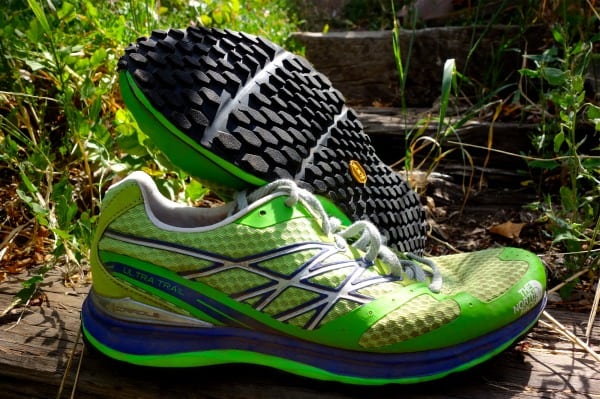
The North Face Ultra Trail
Another addition from The North Face:
The North Face Ultra Smooth ($110 – January 25, 2014) – Essentially the Ultra Trail for the road and smooth trails. The outsole and Vibram ground-contact EVA aim to provide a smoother ride for this 9.3 ounce (263 g) shoe.
Vasque Ultra SST (née Shapeshifter Ultra) ($170 – March 15, 2014)
The Vasque Ultra SST (née Shapeshifter Ultra) aims to conform to your foot and the terrain both through materials and geometry. Underfoot, there’s a slightly cupped midsole topped with 4 mm of foam rather than a strobel board and a traditional insole. The midsole material is used extensively in the structural elements of the shoe, including the toe rand, the heel counter, and even the metatarsal wrap up to the eyelets. The upper is a pull-on fit with a BOA lacing system. As for ground conformity, the extensive midsole in the shoe’s 22/28 mm stack heights (6 mm drop) enhances ground conformity along the same line as Hokas and La Sportiva’s Morphodynamic shoes, while the Shapeshifter’s individual pillars allow for more mechanical deformation. Like Hoka’s Conquest, this is one for which judgment will have to be left to the trails.

Vasque Shapeshifter Ultra
ASICS Fuji Racer 3 ($110 – November 1, 2013)
The 8.7 ounce ASICS Fuji Racer 3 features entirely new midsole/outsole tooling and a brand new upper in a 6 mm drop shoe. ASICS added ground contact to the outsole, spaced out the lugs for better mud shedding, and closed in the underfoot drainage holes. The Fuji Racer 3 retains its water-drainage feature by creating underfoot channels (that correspond to forefoot flex grooves) that drain out of the side of the midsoles.
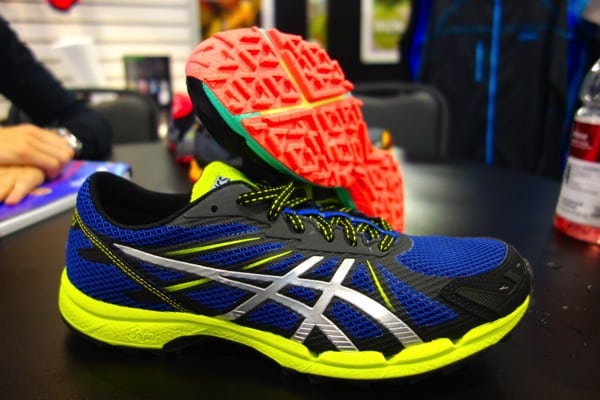
ASICS Fuji Racer 3
Saucony Peregrine 4 ($110 – January 1, 2014)
From the looks of things, Saucony is making the Peregrine a franchise shoe. What else can you say when the Saucony Peregrine is the fourth generation of a yet-to-be-completely-revamped shoe. In that way, it reminds me of the Cascadia of the past half decade. In 2014, the Peregrine will get another millimeter of lug depth to go along with a more aggressive outsole pattern. On the other hand, the shoe’s rockplate has been thinned, which should lead to a more flexible forefoot. The midsole material goes from Progrid to Powergrid, while the upper sees a thinning of the Flexfilm overlays as the material continues to replace additional traditional overlays. The toe box should be more roomy thanks to a new upper pattern and the Flexfilm updates. The Peregrine remains a 4 mm drop shoe that will sit at 9.4 ounces.

Saucony Peregrine 4
SCARPA TRU ($109 – February 2014)
Following on the surprise success of the Spark, the SCARPA TRU is a trail racing shoe built with SCARPA’s concept of “mountain minimalism” – lightening things up, but still offering adequate protection and support – in mind. The result, a 8.5 ounce, mountain-worthy trail racing shoe.The TRU has a 6 mm drop and a very breathable upper.

SCARPA TRU
Other additions from SCARPA:
SCARPA Ignite ($125 – February 2014) – Where the TRU brackets the Spark on the lighter side, the Ignite does so on the upper end. It’s a new take on a traditional trail runner that comes in at 10.2 ounces with a 8 mm drop (10/18 mm midsole heights) and a rock plate as well as a real outsole (4.5 mm lug depth).
SCARPA Ion ($120 – February 2014) – This appears to be a slightly more protective version of the Spark, with a 1.2 EVA rockplate rather than the Spark’s fabric rock protection. It’ll weigh 10.3 ounces.
Merrell AllOut Collection ($110-120 – February 2014)
Merrell’s AllOut collection is a good example of the pendulum swinging back to the center on drop. Neither Merrell nor the other companies that saw huge booms with 0 to 4 mm drop shoes are dropping those models, but they’re realizing that some consumers want and/or need more drop. Hence, the addition of the 6 mm AllOut collection. The Merrell AllOut Rush ($120) appears to be a traditional trail shoe at 10 ounces with 5 mm of lug depth… it’s just got a 6 mm drop. The Merrell AllOut Fuse is a 8 ounce, door-to-trail shoe with 2.5 mm lugs.
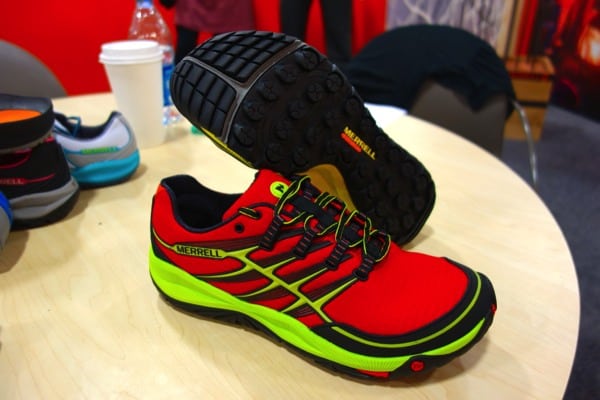
Merrell AllOut Rush
Brooks Cascadia 9 ($120 – February 1, 2014)
The eighth update to the classic Brooks Cascadia focuses on the upper with less sewing there. New flat laces reduce pressure points. Count on this one as a “don’t mess with a good thing” update. The latest version weighs in at 11.7 ounces for a US men’s 9.
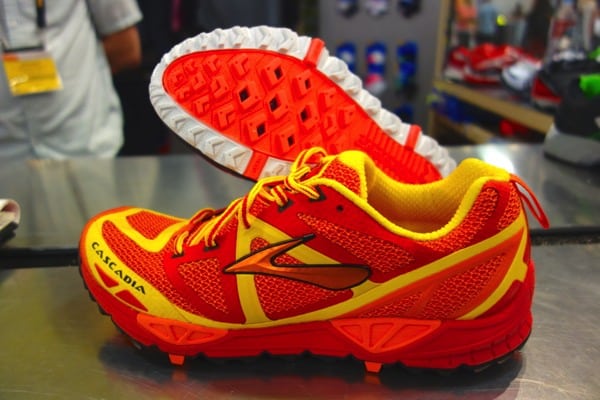
Brooks Cascadia 9
Dynafit Pantera ($125 – Feb 15, 2014)
In talking with Henry Guzman of Boulder Running Company, who played a large part in the development of the Dynafit Pantera, the shoe fills the hole still empty from the departure of the Montrail Hardrock and is a shoe made for the “other 80%.” It’s a solid, protective, well-lugged shoe (that looks even luggier than it is) that’s snug in the midfoot and open in the toebox. The 8-mm drop Pantera weighs in at 12 ounces (340 grams).
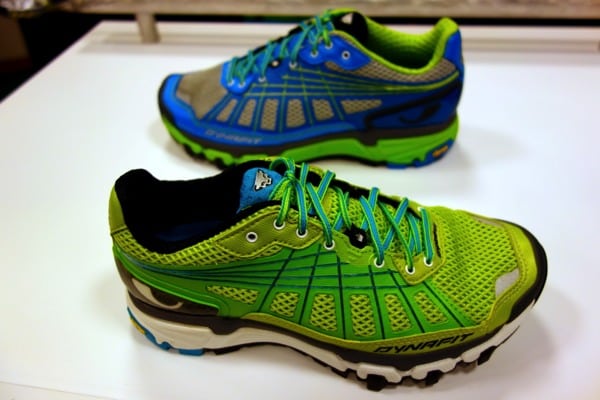
Dynafit Pantera
Vibram Vybrid (Concept Stage)
Vibram’s currently test marketing a 14-mm-stack-height FiveFinger model, the Vibram Vybrid, at a Boston-area store. It’s currently in the concept stage, but worth noting in the context of other developments at this year’s summer OR show.
Other updates from Vibram:
Bikila EVO ($120 – February 2014) – The Bikila’s sole is increased from 7 to 8.5 mm and there’s a new antimicrobial upper.
Montrail
While Montrail is introducing two new models next spring – the FluidFlex II ($90 – February 1, 2014) and FluidFeel II ($110 – February 1, 2014) – both are incremental tweaks to their predecessors. The FluidFlex II seems to be an update to the fit of the upper as well as providing additional medial structure. The biggest update on the FluidFeel II is aesthetic; however, the upper is now more breathable.

Montrail FluidFlex II
While the Bajada remains the Bajada, it may have seen the most meaningful changes in the Montrail line with Fluid Foam being added and the upper mesh being improved to reduce blowout issues.
Rogue Racer fans… stock up this season, the finale for this model.
[Looking for Outdoor Retailer Winter 2013]
Best Trail Running Shoes of Outdoor Retailer Summer 2012
(Originally published August 9, 2012)
Twice a year, I attend the Outdoor Retailer show in Salt Lake City, Utah. I then spend three or four months avoiding writing about the best of the ridiculous amount of gear I’ve seen at the show. Not. This. Time. OR ended Sunday and this preview of the best trail running shoes from the show is going up on the subsequent Gearsday, as we like to call Thursday around the office. So here they are – the shoes you want to know about now and might very well want to run in come Spring 2013.
Click on any of the following featured shoes to jump down to our preview of the model. If you don’t find what you’re looking for on this list, try searching this page as we provide abbreviated previews on a number of other models. We’ve also published a more extensive photo set of the shoes of Summer OR ’12 on our Facebook page.
- Altra Superior
- Asics GEL-FujiTrainer 2
- Brooks Cascadia 8
- Brooks Pure Grit 2
- Dynafit Feline Ghost
- Hoka One One Bondi B 2
- La Sportiva Helios
- Montrail FluidFlex
- New Balance Leadville – MT1210
- New Balance Minimus Hi-Rez
- Patagonia EVERmore
- Pearl Izumi E:Motion Line
- Salomon S-Lab Sense Ultra
- Saucony Peregrine 3.0
- Scott T2 Kinabalu
- The North Face Hyper-Track Guide
- Vasque Pendulum
Pearl Izumi E:Motion Line ($115-130 – February 2013)
With nine models, including three new trail models, I’m not going to preview any single model in Pearl Izumi’s new E:Motion Line. Instead, I’ll generally talk about a line that had me intrigued the past few months, pleasantly surprised on the OR floor, and smiling during every run in them since. Quite simply, the E:motion line was the best new footwear concept I saw at this year’s OR.
The E:Motion line, which will debut in February 2013, is all about feel rather than technical features… and both shoes I’ve tried – the Road N1 and Trail M2 – have felt great. The underfoot packages in both models (and, especially, the road model) have exceptional fluidity. I’ve experienced an easy footstrike and a smooth-as-silk transition that I don’t think I’ve ever felt in another shoe in twenty years of running. Not hyperbole, but fact. It’s 2:30 am and thinking about these shoes has me itching for a second run… and the upper is spectacular, as well. The seamless uppers with minimal overlays are incredibly comfortable. Oh, and no model in the entire line weighs more than 10 ounces.
The are only two possible downsides I’ve seen to the line and they work in tandem. You see, there are four road-, three trail-, and two triathlon-specific models with three types of stability – N (neutral), M (midfoot stability), and H (heel stability) – and three levels of cushioning – 1 (lowest), 2, and 3 (highest). While eminently sensible, I can see folks getting confused between a Road N2, Trail N2, and a Trail M2, both while chatting with friends and at the store. The somewhat unified (and entirely awesome) colorways is likely to add to the confusion.
Here’s a video Pearl Izumi produced with an overview of Project E:Motion.

Timothy Olson wearing the Pearl Izumi Trail N1 after setting the course record at the 2012 Western States 100.
Montrail FluidFlex ($90 – January 2013)
The Montrail FluidFlex is the most radical departure from its norm that Montrail has taken in quite some time. The FluidFlex is a rockplate-free, 7.6-ounce, 4 mm-drop shoe. Yeah, that’s not your mom’s Montrail Hardrock right there. Plus, it’s based on Montrail’s new midsole material, FluidFoam (not to be confused with Montrail’s FluidPost, which is not found in any of Montrail’s “FluidXxxx” shoes) that yields a softer ride than (and is preferred in tests over) traditional midsole EVA.
Other new models from Montrail: FluidBalance (a sub-10 ounce hybrid with a 10 mm drop on the FluidFoam platform); FluidFeel (8-mm drop, 10.3-ounce everyday trainer riding on FluidFoam; replaces the Fairhaven, keeping the midsole tooling but ditching the upper).
La Sportiva Helios ($120 – March 2013)
The La Sportiva Helios is the first of two major examples of a company turning back the dial on its cutting edge shoe model to reach a balance between concept and performance. At only 1.2 ounces more than the Vertical K (8.1 vs 6.9 ounces), the small changes to the VK platform may make the Helios an ultra-distance option for a much larger number of runners. While the outsole material and pattern are similar between the two models (the Helios uses a more durable FriXion compound), the Helios has a significantly wider footprint that will offer stability to a tired runner. Atop the outsole, La Sportiva uses the same midsole material, but with a 2 mm LaSpEVA plate in the Helios. The upper of the Helios offers more structure than the Vertical K as well as a wider toe box. All in all, the the Helios is a more structured, more protective Vertical K, which should allow for the shoe to be an every-day trainer rather than a racing/fast training shoe.
Other new shoes from La Sportiva: Anakonda ($125 – replaces the X-Country and C-Lite; has 4 mm drop and hard heel stabilizer for off-trail use), Quantum 2.0 ($130 – changes to Vibram outsole with opposing lugs; broader fit), Ultra Raptor ($130 – rides softer than the original Raptor, lower drop at 8 vs 12 mm, lost a little weight), Women’s Vertical K.
Salomon S-Lab Sense Ultra ($180 – January 15, 2013)
The Salomon S-Lab Sense Ultra, the followup to the original S-Lab Sense, could win an award for the biggest improvement through the smallest changes. The first change is a firming of the durometer (softness) of the midsole that should greatly increase durability. Second, Salomon is dropping the price $20 from $200 to $180. Third, Salomon has added lugging to the formerly bare midfoot area. Fourth, the ProFeel Film has been extend backward to provide a bit more midfoot protection. Finally, for the aesthetically modest, the formerly red and white shoe will now be a slightly less flashy combination of red and black. The changes to the shoe result in a slight increase in weight to 7.4 ounces and represent a trend of scaling back bleeding-edge minimalism/ultralightness to allow for greater durability and practical comfort levels.
Other new models from Salomon: Sense Mantra (consumer/trainer version of the S-Lab Sense; only $120; 6 mm drop; 1 ounce heavier than S-Lab Sense); Crossmax 2.
The North Face Hyper-Track Guide ($120 – Spring 2013)
Next season, The North Face is introducing a new line of trail shoes based around its new Cradle Guide technology in which two irregularly-shaped midsole pieces are molded together without glue or hard edges. The layers are contoured differently depending on the model to cradle your foot as warranted by the specific shoe model and its intended uses.
The racier of the three new Cradle Guide shoes is The North Face Hyper-Track Guide, which weighs in at 9.5 ounces. Going forward, The North Face intends to distinguish its trail shoe models as being designed for rocky or smooth terrain and the outsole of these shoes speaks that the Hyper-Track are intended for smooth terrain. TNF did include a plastic “heel clip” primarily to lock the heel in place, but left torsional flexibility to allow for different types of footstrikes on different aspects (climbing/descending/cambered). A welded upper removed many seems.
Other new shoes from The North Face: Ultra Guide (intended for rougher terrain with heavy lugs; channels around each lug smooth out the ride on pavement and hardpack; SnakePlate); Double-Track Guide (traditional stability shoe designed for wider range of people; more medial arch and medial wrap).
Vasque Pendulum ($110 – January 2013)
The Vasque Pendulum appears to be a happy compromise between the now extinct Vasque Transistor and Vasque’s more conventional trail offerings (Mindbender or Velocity 2.0). The Pendulum revives the Transistor’s Fluxfoam and curved strobel, which gave the Transistor a great under-foot feel, but moves the Fluxfoam into a removable footbed. The overall structure of the shoe harkens to Vasque’s traditional strength in the “real trail shoe” category. However, this is in no way a throwback. The shoe also incorporates growing trends in the trail running market, such as a 6 mm drop, a nearly one-piece upper, and a low weight for a full-function trail shoe at 10 ounces.
Altra Superior ($95 – Spring 2013)
Following on the success of the Altra Lone Peak, a burly, well-cushioned trail shoe, the Altra Superior will debut next spring. Aside from being a zero-drop, cushioned trail shoe, the most notable feature of The Superior is its removable rockplate. That’s right, the shoe comes ready to tackle the toughest trails in the Wasatch (or any other mountain range), but transitions to an even lighter, lower, more flexible shoe should you be headed out on some buffed out singletrack or simply desire those qualities. The Superior (8.9 ounces) is a full ounce lighter than the Lone Peak. That weight savings comes from a more stripped down upper as well as less underfoot material that goes along with a lower stack height (19 vs 23 mm).
New Balance Leadville – MT1210 (~$125 – early January 2013)
After a few years of concentrating on the minimal end of the trail shoe spectrum, New Balance has put time and effort into a more traditional trail shoe, the New Balance Leadville, which is named after the Leadville Trail 100 race that the company now sponsors. Before getting techy, its important to note that these shoes were developed with ultrarunning specifically in mind. New Balance sent its product team to a multi-lap trail ultra (for the record, the Mount Agamenticus 50k) to take foot scans every lap to map foot expansion, which they mapped at 7% overall. As a result, the shoe was designed to allow expansion on the top of the foot as well as in the toes. They also found that runners’ arches dropped during the race, so they’ve included a small medial post in the shoe. On the tech side, the Leadville incorporates New Balance’s ultralightweight FantomFit upper construction, which I believe is only found in two other models, the RC5000 racing flat and the next shoe we’ll discuss. The Leadville has a well-lugged Vibram outsole, a forefoot rockplate, and fully-gusseted, welded tongue with no stitching. As for numbers, the shoe weighs in at 10.3 ounces and has an 8 mm drop.
Updates to existing New Balance models: MT10v2/Minimus Trail (increased outsole flex along with reduced lug size in low-wear areas; about an ounce lighter; redesigned forefoot band with more give; redesigned liner for better Achilles comfort); MT110 (dropped lateral side of shoe 1 mm).
New Balance Minimus Hi-Rez ($120 – April 2013)
Okay, this is not a trail shoe… and it’s barely a running shoe, but I’ll be asked a million questions about it, so here it is, the New Balance Minimus Hi-Rez, a 4.3 ounce, zero-drop, 8-mm-stack-height shoe with FantomFit construction. Oh, and it’s got 40-some fully articulated midsole pods laminated onto the fabric that’s directly below your feet. Those pods are primarily a midsole compound with only a small portion of lugs in high-wear areas cover with any outsole compound.
Again, this is not a trail running shoe. The pods will stay coupled to the shoe during its couple-hundred-mile life, but all bets are off when descending a rocky slope at high speed! Personally, I’d use the Hi-Rez as a non-running trainer to help strengthen my feet and lower legs as I go about my day… knowing that I could break into a sprint at any time.
Brooks Pure Grit 2 ($110 – January 1, 2013)
The Brooks Pure Grit 2 consists of the same midsole and last as the original Pure Grit, but there are major updates to the outsole and upper. On the outsole, there are smaller, multi-directional lugs that should greatly increase traction. On the upper, the nav band is now exposed and extended over the entire lateral side and there’s a full tongue wrap. Reinforcement has also been added to the toe. The changes will mean that the Pure Grit officially goes from 8.9 to 10.0 ounces.
Brooks Cascadia 8 ($120 – February 1, 2013)
Until we’re proven wrong, revisions – even minor – to the Cascadia line warrant inclusion in our OR wrap ups. The biggest updates with the Brooks Cascadia 8 come in the midsole where the the drop was lowered from 12 to 10 mm (the heel was dropped from 22 to 20 mm, while the 10 mm forefoot height remains unchanged) and BioMoGo was blended with Brooks DNA in the midsole. This blend removes glue and hard edges between various midsole components. Underfoot, the lugs have also been redesigned, while in the upper there have been slight changes to the shape and material found around the toebox. The latest version of the Cascadia will weigh 11.9 ounces, which gives the Cascadia the following official progression in going from the Cascadia 5 to the Cascadia 8: 12.0, 11.2, 12.2, and 11.9 ounces.
Scott T2 Kinabalu ($120 – January 2013)
Scott’s trail shoes have come a looooong way in the past couple years. The first pair I tried a few years back wasn’t worth more than a run. Then, last winter, I gladly logged some runs in a newer model. Now, Scott is transferring its road know-how into its trail shoe line with the Scott T2 Kinabalu. I’ve yet to run in these fully-featured 9.8 ounces shoes with a conventional drop (11 mm), but would gladly give them a few spins around the mountain. These shoes were designed with water in mind with a perforated sockliner and channeled midsole that leads to drainage ports.
Asics GEL-FujiTrainer 2 ($100 – January 2013)
The US has only had the Asics GEL-FujiRacer for a few months, while the Japanese have already had another Fuji model – the FujiTrainer. Well, next year, America gets in on the action with the Asics GEL-FujiTrainer 2. The FujiTrainer is one ounce heavier than the FujiRacer (9.7 vs 8.7 ounces) and comes with a 8 mm drop. The upper features a gusseted tongue, lace garage, and open mesh fabric. The outsole has a more aggressive lug pattern than the FujiRacer while lacking the racer’s drainage ports.
Hoka One One Bondi B 2 ($160 – Spring 2013)
How did a road shoe – the Hoka One One’s Bondi B 2 – get in here? Because I see a heck of a lot of the original Bondis out here on the trails of Utah. With the Bondi B 2, Hoka focused on improving the shoe’s upper. There’s a new, more open mesh as well as revised overlays that should reduce friction. There’s also a softer ankle pad to increase comfort. Finally, there are now heel and tongue pulls to help get your Bondi B 2s on more easily.
For a more complete look at some of Hoka One One’s newest models, as well as at the 2012 Speedgoat 50k and some personal Hoka stories, here’s a not quite final version of a forthcoming Hoka video.
[Click here if you can’t see the above video.]
Saucony Peregrine 3.0 ($110 – March 2013)
Saucony continues to dial things in with its Peregrine line. No longer on the minimal side of things, the Saucony Peregrine 3.0 is best described as a lightweight (9.9 ounces), low-drop (4mm) real trail shoe. In this iteration, Saucony added more sticky rubber to the center of the shoe for increased traction on hard and/or wet surfaces. The company also opened up the upper’s mesh a bit to increase breathability. Other than that, it’s the same great Peregrine.
Patagonia EVERmore ($110 – February 2013)
The Patagonia EVERmore continues in the direction Patagonia Footwear took with the Fore Runner. That is, focusing on lighter weight and more minimal structure. At 7.8 ounces, the EVERmore is certainly light, while it’s even lower to the ground with a 17/13 mm stack height, which yields the same 4 mm drop as the Fore Runner. The EVERmore has neither an arch shank nor a heel counter, but it does have a small forefoot rockplate. The shoe is also built around a new last with a more roomy toebox.
Other new shoes from Patagonia Footwear: Fore Runner EVO ($120; updated lining; more forefoot wrap; more drainage ports); Gamut ($125; follow up to the Specter with better out-of-the-box comfort).
Dynafit Feline Ghost ($130 – March 2013)
The Dynafit Feline Ghost is a step in the right direction for the company. At 9.2 ounces, this looks like another strong entry into the sub-10 ounce, real-mountain-running-shoe category. It’s got cushioning, stability, and protection all in a lightweight package that rides atop some solid lugging. These might very well be worth checking out in person.
Shoes Omitted, But Not Forgotten
I’ve only got so many hours in the day, so I tried to be better about sticking to the most core trail running products above. However, I collected lots of info on other new shoes, such as these:
- Born 2 Run – A minimalist shoe with the big toe completely separated from the other four;
- Merrell’s M-Connect Line, including the Vapor Glove and Road Glove 2; and
- Teva TevaSphere – A rounded heel design.
Call for Comments
As always, we’d love to hear your thoughts on these shoes. We’ll also try to answer any questions that you have!
Best Trail Running Shoes of Outdoor Retailer Winter Market 2012
(Originally published February 16, 2012)
Following up on yesterday’s article on the best trail running gear we saw at this winter’s Outdoor Retailer show, here’s a sneak peak at the best trail running shoes we saw there.
[If you want to read up just-released or soon-to-be released shoes, check out our article on the best trail running shoes of summer 2011’s OR.]
From the Ultimate-Ultrarunning-Race-Shoe dept.
Salomon S-Lab Sense (May/June 2012 – $200)
While we fully previewed the Salomon S-Lab Sense back in December, this was the Sense’s OR show debut so it deserves mention. At 6.5 ounces and sporting a 4 mm drop, this is the consumer version of what Kilian Jornet raced in last year. Aside from being designed to be lightweight and extremely breathable, the shoe’s Endofit system provides a remarkably comfortable fit. I’ve yet to wear the shoe sockless, but that’s what Salomon was aiming for with Endofit.
New Balance Minimus Amp (MT1010) (July 2012 – $105)
We’ve also previewed the New Balance Minimus Amp/MT1010, but as this shoe was still hush-hush at last year’s summer OR, it’s ripe for inclusion here. The MT1010 will be the kind of shoe that many a minimalist shoe fan could wear everyday as well as when running a technical 100 miler. At 7.7 ounces, it’s the same weight as the newly released MT110, but with an outsole package and upper that seem a bit more robust. Those attributes are likely to make the MT1010 a good option for those who find the MT110 to have an awesome feel for the first five or ten miles, but might not be able to handle that little shoe in, literally, the longer run.
Saucony Kinvara TR (July 2012 – $100)
Saucony’s Kinvara road running shoe has quite the following among the minimalist crowd. Saucony originally ported the Kinvara idea to the trails with the Peregrine line. Now, the company is coming out with the Kinvara TR (8.5 ounces) in another attempt to replicate the road-based Kinvara’s fit and feel. To start with that effort, the Kinvara TR shares its road kin’s 4 mm drop with stack heights of 12.5 mm (toe) and 16.5 mm (heel). The upper is a light mesh with a protective toe wrap. Underfoot, there’s a full rockplate that extends through the midfoot and an outsole featuring multidirectional lugs made from sticky rubber. In other words, this is a trail shoe. One feature that caught my eye was the pair of Hydramax pods located in the heel’s interior that were included for heel lockdown.
From the I’ve-Run-Up-Green-Mt-With-2-Feet-of-Fresh dept.
New Balance MT110 Winter (October 2012 – $120)
Ok, now for something new! This autumn, New Balance will release a winter version of its hit shoe, the MT110. What does that mean? Essentially, the Winter MT110 is a waterproof MT110 with an integrated gaiter. (To the best of my knowledge, the gaiter itself is not water resistant.) Other than not having to put on a gaiter before heading out to traipse through knee deep powder, the main advantage of this setup is that the upper of the underlying MT110 could be lightened. Otherwise, you’re getting the same awesomeness of the MT110. If you look closely, you can already find lots of pics of Anton Krupicka running the Front Range (and southern California) in the MT110 Winter.
Salomon Snowcross CS (Fall 2012 – $200)
Salomon is also getting into the integrated-gaiter winter running shoe niche with its forthcoming Snowcross CS. In the Snowcross, the waterproof membrane is only selectively placed on the main portion of Snowcross’s upper, specifically on the front and top. The thinking behind this is to prevent moisture from melting snow from entering the shoe from where the snow likely to be sitting while allowing the rest of the shoe to breath much better. The Snowcross is largely based on the Speedcross 3, although the upper does include some of the advanced materials and construction methods used in Salomon’s S-Lab line.
From the Brits-Make-Play-on-American-Soil dept.
Inov-8 Trailroc 255, 245, 235 (July 2012 – $120)
This summer, Inov-8 debuts an entirely new line of trail shoes, the Trailroc series. Whereas Inov-8’s lineage comes from boggy British fell running, the Trailroc line is specifically designed for more hardpacked trails here in the US. Generally, the Trailrocs have a lightweight mesh upper sitting on an outsole with numerous (~75 for a moderately sized shoe) medium height lugs located consistently from heel to toe. The outsole uses three different rubber compounds that puts Inov-8s more durable Endurance rubber in higher use areas and its more grippy Soft Sticky rubber in areas where performance need not play second fiddle to durability.
The Trailroc line has three models that correspond with each model’s weight: 255, 245, 235. As you go toward the light models, the upper becomes more minimal while both the stack height and drop lower. The 255 has stack heights of 10 and 16 mm (6 mm drop), the 245 has heights of 8 and 11 mm (3 mm drop), and the 235 is 6 mm at both the forefoot and heel (zero drop). The 255 and 245 both have Inov-8’s Meta-Shank articulated rockplate. The Trailroc 235 lacks a rockplate.
From the In-Another-Life dept.
New Balance RC 5000 (June 2012 – $125)
Even a trail runner can drool over the well-manifested concept of a 3.2 ounce track racing flat. From the beautiful upper to the less dense “RC” racing compound REVlite midsole, this is the sort of shoe that moves the entire field forward. Give me two hours with the New Balance design team and the budget for a proto and I’d have once sweet-as-heck, sub-five-ounce shoe for Leadville.
New Balance RC 1400 ($100)
Ok, this shoe is already on the market, but I’ll admit to only having seen it in passing… it is a road shoe, after all. That said, the RC1400 is the conceptual favorite for my Leadville shoe this summer. For me, a ~7 ounce, 10mm drop, cushioned shoe sounds just about perfect for a highly runnable 100. I’ve still got to see if it works for me during long runs and on non-technical trails, but I’ve got no indication that it won’t.
Call for Comments
- Alright, which of these shoes are you lusting after and how do you plan to use them?
Best Trail Running Shoes of Summer Outdoor Retailer 2011
(Originally published August 15, 2011)
Every August, Salt Lake City sees the announcement of the vast majority of the following year’s top trail running shoes at the Outdoor Retailer show. This year was no exception. From barebones minimalist to comfy zero drop shoes, from everyday hybrid trail runners to sleek new racing shoes, I saw a closet’s worth of shoe-lust worthy trail running shoes. Here’s a look at some of my favorite models. Additional photos of many models can be found in iRunFar’s Facebook album for the show.
For easier navigation, we’ve added links that jump down directly to the following previews:
- New Balance Minimus Trail Zero – MT00
- Brooks PureGrit
- Montrail Rogue Fly
- The North Face Hayasa
- Altra Lone Peak
- Brooks Cascadia 7
- Hoka One One Stinson B Evo
- Merrell Glove Line Extensions
- New Balance Minimus Road Zero – MR00
- Salomon XR Mission
- SCARPA Spark
- Vasque Velocity 2.0
- Vibram Spiridon LS
- La Sportiva Vertical K
- Montrail Bajada
- New Balance MT110
New Balance Minimus Trail Zero – MT00 ($100 – February 2012)
[Update: We now have a full review of the New Balance Minimus Trail Zero.]
The NB Minimus Trail has been a big hit and New Balance is ready to take the next step with the MT00, aka the Minimus Trail Zero. (Don’t worry Minimus fans, both the current Minimus Trail and Minimus Road, with their 4 mm drops, will remain in the line.) To start, the Minimus Trail Zero gets its namesake feature in a zero drop platform. This minimalist approach has been extended from the midsole into the outsole where New Balance looked at couple dozen pairs of used standard Minimus Trails to determine the 10 most worn lugs. NB then used that data to selectively cover only the most worn lugs with outsole rubber while leaving the midsole exposed. In addition, the Minimus Trail outsole was also reduced by coring out the outsole rubber down to the midsole in the hollows between the lugs.
The upper is radically different. It’s primarily made from one piece of a fabric that seems more like nylon than running shoe mesh. That material is thin enough that you can see your toes through the upper. That upper is fleshed out by one piece of overlay; very small reinforcements at the toe, eyelets, and heel; and slight padding in the ankle collar and heel. There’s a soft, single-layer synthetic tongue with flat laces to reduce lace bite. The eyerow has been reduced from 6 to 5 eyelets. The lasting is similar to the current Minimus Trail… but with a zero drop.
All of these changes yield a 4.4 ounce shoe!
Here are 9 things you should know about the Minimus Zero straight from New Balance.
New Balance Minimus Trail Zero – MT00 ($100 – October 1, 2011)
[Update: We now have a full review of the Brooks PureGrit.]
There’s been quite a bit of chatter in the trail running ranks about Brooks’ PureProject and, particularly, the trail-specific shoe in the project, the PureGrit. That buzz isn’t surprising considering the historic popularity of the Brooks Cascadia and the current trend toward minimalism. Brooks’ goal with the PureProject line is to “promote your natural stride.”
So what’s the Brooks PureGrit? An 8.4 (or is it 8.9) ounce (US men’s 9, 7.6 oz for women’s 7) low to the ground (15 mm heel, 11 mm toe) 4 mm drop trail specific shoe designed, like the Cascadia, with input from Scott Jurek.
According to Brooks, the five main tech features of the PureGrit:
- Ideal heel – An extremely curved heel that prevents you from landing behind the center of the heel/ankle joint.
- Nav Band – An elastic band across the laces to create a more secure fit.
- Toe Flex – The sole and upper surrounding the big toe are separate from the other toes allowing for better ground feel and response.
- Midsole Foam – Brooks has blended in its DNA midsole compound throughout the midsole to respond to a runner’s need.
- Anatomical Last – A different last than used for the Cascadia that has a more curved, foot-like shape.
The shoe has a generally convex outsole that provides great feel and allows 2-4mm of splay in the outsole to provide additional traction. There’s no rockplate, but an aggressive outsole that runs the length of the shoe (i.e., no cut outs) for protection. Brooks added a center strike zone “pod” to inform the foot where the center of the shoe is. The highly permeable light-mesh upper that lets water in… but let’s it right back out. The tongue is padded only in the center, which I like as it saves weight without losing function or sacrificing comfort.
Montrail Rogue Fly ($120 – February 1, 2012)
What happens when you strip down the already lean Montrail Rogue Racer? You get the Montrail Rogue Fly! Both models use exactly the same outsole, midsole, and rockplate, but at 7.6 ounces for a US men’s, the Rogue Fly is 13% (1.2 ounces) lighter than the Rogue Racer. All that weight savings comes from stripping the already light Rogue Racer upper down ever further. The upper consists of two pieces of mesh and a tongue. That’s just about it. There aren’t any overlays with the exception of a small heel overlay for structure nor is there any under webbing across the metarsals from the midsole to the eyelets. While this is a racing shoe, it’s not meant to be run in sockless. The Rogue Fly has a 10 mm drop with 18mm at the heel and 8 mm at the forefoot, just like the Rogue Racer.
The North Face Hayasa ($110 – Spring 2012)
Last year, The North Face created a great trail running platform in the Single-Track. If TNF beefed up Single-Track into the Double-Track this year, then next year it’s putting its flagship model on a diet in the form of the Hayasa![]() (“speed” in Japanese). In the Hayasa, The North Face have built an 8.3 ounce (US men’s 9) shoe that doesn’t sacrifice protection. To save weight, TNF dropped the midsole to 18mm in the heel and 8 mm in the forefoot (10 mm drop) and by minimizing the upper which now features a “geodesic cradle” to lock your foot in place. The upper looks supportive, lightweight, and quite breathable. Seams have been minimized in this neutral trail runner that gets stability from a heel cup and support from a midfoot shank.
(“speed” in Japanese). In the Hayasa, The North Face have built an 8.3 ounce (US men’s 9) shoe that doesn’t sacrifice protection. To save weight, TNF dropped the midsole to 18mm in the heel and 8 mm in the forefoot (10 mm drop) and by minimizing the upper which now features a “geodesic cradle” to lock your foot in place. The upper looks supportive, lightweight, and quite breathable. Seams have been minimized in this neutral trail runner that gets stability from a heel cup and support from a midfoot shank.
This shoe excited me when I first was it in January at winter OR and I’m even more excited now that I’ve had a chance to slip it on my foot. The Hayasa is a giant leap forward for The North Face.
Additional Shoes
I’d originally intended to intended the following to be briefer previews of a larger set of sweet new shoes I saw at summer OR. So much for briefer! Read on for another dozen shoe previews!
Altra Lone Peak ($99 in specialty running stores/$105 online – November 2011)
[Update: We now have full review of the Altra Lone Peak.]
At this point, you might think you’ve seen every iteration of zero-drop trail running shoe… but that’s not true unless you’ve send the Altra Lone Peak. The shoe (along with its roady cousin, the Instinct) was designed by long-time runners and running store employees along Utah’s Wasatch Front who were “zeroing” shoes by detaching outsoles, grinding down midsoles, and reattaching the outsoles well before others were talking about drop, let along zero drop. Anyway, these guys have created a line of fully cushioned zero drop running shoes with a rockplate inset into the midsole layers and a “mud rudder” rear outrigger a la the early 90s Adidas Trail Response. They claim that the 9.9 ounce Lone Peak has the same protection as a Brooks Cascadia while running like a New Balance MT101 or Montrail Rogue Racer.
Brooks Cascadia 7 ($110 – February 1, 2012)
[Update: We now have a full review of the Brooks Cascadia 7.]
It’s safe to say that I’ve never been more excited about the seventh iteration of a shoe. The Cascadia 4 may still be my favorite trail shoe of all time, while the Cascadia 6 didn’t live up to my admittedly very high expectations. I still love the Cascadia 6 on nearly all terrain, so please don’t think I dislike the shoe. It’s still on the top row of my shoe rack. My primary concern with the Cascadia 6 was reserved for steep or technical downhills during which the upper would let my foot shift forward. I was far from the only one to note this. It’s my belief that the two “floating” medial (instep) eyelets did their job in relieving pressure on the top of the foot a little too well. Fortunately, those eyelets are now secure and I’ll be psyched to get into the Cascadia 7.
… and the rest of the scoop on the Cascadia 7? It uses the same rockplate and the same midsole, including the BioMoGo DNA material, at the Cascadia 6, but the outsole has been updated. Brooks was getting feedback about outsole wear, so they’ve replaced the 6’s circular saw lugs with a more durable lug configuration. In the end, the weight (12.2 oz for US men’s 9) will be very similar to that of Cascadia 6, with the weight of the upper being reduced and that of the outsole being increased.
Hoka One One Stinson B Evo ($170 – February 2012)
Out on the trail all Hokas might look the same, but the models are quite a bit different. With its forthcoming Stinson B Evo takes many of its lessons from the Mafate and Bondi B to make, what I think, is a much improved shoe. The outsole shape is somewhere between the Mafate and Bondi B, but the bit changes come with the outsole details and midsole structure. First off, the lug height on the Stinson B has been increased and, therefore, so has the shoe’s traction. A combination of new flex grooves in the outsole and a change in the midsole compound give the shoe more flex making it much more responsive than previous models.
The Stinson comes with a speed lacing system as well as traditional laces. In addition, the shoe will come with both a thin and think insole. In addition, the Stinson B is designed to be “tuned” by individual runners by drilling thin holes in the particular areas of the midsole where they would like the shoe to be softer such that the foot will travel more in that direction.
Merrell Glove Line Extensions
I believe I overheard at the show that the Merrell Trail Glove is currently the top selling trail shoe in America. Whether or not that’s true, the Merrell Glove line has jumped out of the gate and continues to barrel along. Here are some updates to the line.
Merrell Trail Glove
Merrell will be adding widths to its popular Trail Gloves.
Merrell Road Glove ($110 – February 2012)
Merrell will be adding a road shoe fittingly coined the Road Glove. Both the men’s and women’s specific models will have a wider forefoot than the Trail Glove to allow for more toe splay. Unsurprisingly, Merrell took out its 1 mm rockplate, thus allowing for more flex and greater ground feel, and incorporated a smoother outsole.
Merrell Bare Access ($90 – February 2012)
For those looking for a more comfortable transition to barefoot or minimalist running, Merrell’s releasing a cushioned zero drop shoe, the Merrell Bare Access with 8 mm of cushioning.
New Balance Minimus Road Zero – MR00 ($110 – February 2012)
[Update: We now have a full review of the New Balance Minimus Road Zero.]
New Balance will also be releasing a 6.4 ounce, zero drop road shoe in the Minimus Road Zero or MR0o. This shoe has a rubber outsole covering 50-60% of the shoe’s bottom (according to my highly unscientific eyeball measurement) that accommodates a midfoot strike. This will be the first New Balance road runner with a Vibram outsole, which has softer rubber and greater flexibility. There are low, flat lugs and, just as in the MR10, a Revlite midsole. The one piece upper is more substantial than the MT00, but still includes minimal overlays. There’s a “burrito tongue” wrapped from the medial (instep) side. The eyelets have been reduced from 6 in the MR10 to 4 in the MR00.
Salomon XR Mission ($110 – February 1, 2012)
Salomon continues to expand its trail running line with the XR Mission![]()
, a door-to-trail shoe in the vein of this year’s XR Crossmax. The XR Mission is ever so slightly lower to the ground than the Crossmax (20mm-10mm vs 21mm-10mm) and is intended as more of a workout shoe whereas the Crossmax would be an everyday trainer. Unlike the Crossmax, there is one version rather than one neutral and one guidance version. However, the men’s and women’s models are distinctly different based on Salomon lab testing. The women’s shoe has deeper flex grooves, different heels to accommodate a woman’s Q angle, and different Sensiflex panels in response to the fact that a woman’s foot changes shape 20% more than a man’s during running.
Saucony Peregrine 2 ($100 – March 1, 2012)
Earlier this year, we reviewed the Saucony Peregrine. Next year, Saucony is releasing the Peregrine 2 and they’re not messing too much with a good thing. The shoe remains the trail version of the company’s popular Kinvara model. Weighing in at 9.9 ounces for a US men’s 9 (down from 10.1 ounces), the main theme of the update is a reduced upper, which will feature fewer seams, fewer overlays, and, therefore, fewer pressure points, including the removal of the center seam over the toes. Word is they also improved the ankle collar lining.
SCARPA Spark ($115 – Spring 2012)
Next spring, SCARPA is releasing its lightest ever trail running shoe, the Spark. At 9.5 ounces, SCARPA considers this a race ready shoe that embodies its “mountain minimal” concept, which seeks to reduce shoes to their basics while still providing adequate protection. The shoe features a high tensile fabric forefoot for push through protection and either a 6 or 8 mm drop.
Vasque Velocity 2.0 ($120/$150 with GORE-TEX – January 15, 2012)
A full decade ago, Vasque released the Velocity, which was a major step forward in runnability for trail runners. With recent trends, the Velocity has gone from being classified as a trail runner to a light hiking shoe. The Vasque Velocity 2.0 stays true to its heritage while bringing the model back to the running scene. The shoe still has a full-length protective shank and a very aggressive outsole. However, the upper was greatly reduced by removing overlays and using more mesh and the medial post was removed making this a more neutral shoe. The shoe’s also lower to the ground with the heel dropping 3 mm and the forefoot dropping 2 mm.
Vibram Spiridon LS ($120 – February 1, 2012)
Admittedly, I’m neither a barefoot nor a barefoot-style runner, but I thought many of you would want to hear about Vibram’s first dedicated FiveFinger trail running shoe. This 6.8 ounce (US men’s 9; 5.1 ounce US women’s 7) shoe has a 6 mm stack height throughout with a 3.5 mm outsole. There are more lugs than other Vibram running models and these lugs are both more textured and include more edging to improve bite into the ground. The Spiridon LS features a “3D Cocoon,” a very strong nylon textile that’s baked into the sole to disrupt impact. The 3D Cocoon runs the length of the shoe. The shoe includes a slightly beefier upper that includes significant toe bumpers. The Spiridon LS is a lace up rather than velcro model.
In addition, Vibram will also be releasing the SeeYa, a 4.8 ounce “performance model” for dedicated minimalist runners. It’s got a significantly reduced upper as well as a Bikila informed outsole with the midfoot and some other portions cut away. Even the velcro straps have cutouts to reduce weight. I’ll assume that all those interested will have seen this model in the barefooting corners of the internet.
Previously Previewed Spring/Summer 2012 Models
La Sportiva Vertical K ($115 – Spring 2012)
We’ve already previewed the La Sportiva Vertical K, the sweet new 6.5 ounce racing shoe born in the Italian Dolomites. Sportiva has paired an minimal yet supportive upper with its light, highly absorbent MorphoDynamic midsole/outsole system. The result? A highly flexible, protective, ultralight mountain racing shoe.
Montrail Bajada ($115 – Spring 2012)
[Update: Here’s our review on the Montrail Bajada. We liked the Bajada enough that we’re selling it.]
Montrail’s forthcoming Bajada is my favorite trail running shoe to come along in the past couple years. Why? It’s a real, supportive, protective trail shoe that weighs in at only 10 ounces even. For me, that’s in my everyday as well as my 100 miler sweet spot. I wore these for the final 80 miles at Western States and plan to run The North Face Ultra-Trail du Mont-Blanc in them.
New Balance MT110 ($85 – January 2012)
[Update: We’ve now published a technical preview, a full review, and a “The Making of” story (including interviews with Anton Krupicka and Erik Skaggs) for the New Balance MT110.
The New Balance MT110 is the follow up to the company’s popular MT101 model. However, this is no minor update like the transition from the MT100 to MT101 was. With the MT110, New Balance lowered the heel-toe drop from 10mm to 4mm. That’s a big change, but so are the redesigned outsole (grippier) and upper (shinier).
Call for Comments
Not sure I even have to call for comments here, but … ready, set, have at it!
(Ps. What spring/summer 2012 trail running shoe are you most excited about?!)
[Looking for Outdoor Retailer Winter 2011]
Best Trail Running Shoes of ORSM 2010
(Originally published January 3, 2011)
Twice each year, the US outdoor industry gathers in Salt Lake City’s Salt Palace to take a look at the coming year’s product line up. For example, many spring/summer 2011 debuted at the 2010 Outdoor Retailer Summer Market (ORSM). As has become tradition, we’re giving our take on these forthcoming products well after the August show, but before the January/February release of many of these products. Below are some of our favorite traditional trail shoes from the show. There’s a separate article on minimalist shoes from the show and there will be a third post regarding other products that caught our eye. Now, let’s bring on the shoes!
Salomon XR Crossmax Neutral and Guidance ($130)
The Salomon XR Crossmax Neutral is out favorite new hybrid or door-to-trail shoe as Salomon prefers to classify it. I’ve run a great deal in the Crossmax Neutral and it performs quite well on both trail and roads. Well enough, in fact, that I recently ran a 50 mile race having never previously worn the Crossmax for more than 8 miles. Now, that’s trust.
With the Crossmax, Salomon focused on fit, ride, and grip. While the upper combines a few fabrics (and fabric technologies), Salomon tried to limit the amount of stitching. The combination of materials provide a very comfortable, reasonably breathable upper. We’ve found the XT Wings 2 to be quite capable on the roads, but this is another step up. For Salomon’s first attempt to make a shoe that’s as good on roads as the trails, they really nailed the ride. There’s a great heel-toe transition, if you’re into that sort of thing. The outsole is chevron-centric, which provides a solid mix of surface area for the road as well as forward and backward traction on the trails. You can also look for a gusseted tongue and Salomon’s QuickLace in both models. The Salomon XR Crossmax Neutral weighs 11.3 ounce (320 gram) for a US men’s 9 in this post-less shoe.
The XR Crossmax Guidance is essentially the same shoe as the Neutral version with the addition of five support or guidance features. First off, there’s medial posting to offer a bit of support. Second, there’s also more medial material to continue the support at the inside of each stride. Third, the OS Tendon in the midsole and outsole, which helps provides stability and rebound, is straighter than the curved design found in the Neutral version. Fourth, the upper of the Crossmax Guidance replaces much of the welded seems found in the Neutral with stitched seams. This gives the shoe a different fit. Finally, the Guidance upper has more Sensifit, a thin-welded overlay that helps provide structure to mesh in the forefoot. The Salomon XR Crossmax Guidance in a US men’s is 12 ounces (340 grams).
Brooks Cascadia 6 ($110)
There are few trail shoes for which we’re likely to cover every subsequent model. The Brooks Cascadia is one of them. This time around, there’s lots to report. Now in its sixth iteration, Brooks has chopped a full ounce off the Cascadia. While not heavy before, an 11.2 ounce (317 gram) version has us dreaming of running up Hope Pass in the Leadville 100. One addition to the Cascadia 6 is a fourth pivot post, this time in the inside of the forefoot. Another big change is that Cascadia 6 will include Brooks’ DNA “spontaneously adaptive cushioning.”
There are also changes to the upper, the most significant of which appears to be a metatarsal wrap to lock your foot in place. Another upper modification is the addition of a “tongue tie” that should help keep the tongue from migrating. Although the outsole is ringed by familiar lugging, the middle portion of the outsole is filled with 19 lugs each of which resemble a four-lobed version of a radiation symbol. The lug pattern, which has lower lugs in the forefoot, should shed mud better than previous versions.
Aside from the lugs and one colorway for both the men and the women… these shoes are far from radioactive. There are lots of environmentally friendly stories, such as a BioMoGo midsoles and recycled rubber in the outsole, but we’ll save those for another time. You’ll be able to check the shoe out yourself in February 2011.
The North Face Double-Track and Single-Track TH ($110 and $90, respectively)
The North Face made great strides in releasing the Single-Track last year. In the coming year, they plan to follow up on that success with the Double-Track. The Double-Track will be aimed at those who want more shoe than the Single-Track. It is more plush with lots more cushioning as well as some added stability. The Double-Track will feature an external cradle to provide a more secure heel fit without overly control the foot. It will weigh about the same as the Single-Track.
Inspired by athlete Lizzy Hawker, The North Face will be releasing the Single-Track T.H. (Terrain Harness). The main modification to the Single-Track TH model is the addition of a medial post for the runner who needs some pronation control. The aim of this shoe is not to be beefier. In fact, TNF removed the Snake Plate rockplate from the TH. Note, however, that this model does have more cushioning that the standard Single-Track.
Montrail Badrock ($100)
This is our favorite training-focused shoe (i.e., not the Rogue Racer) in Montrail’s Spring/Summer 2011 lineup… and we’ve run in every shoe in the lineup. It’s a solid mix of a runnable midsole/outsole package and comfortable upper. The highlight of the upper is a pleasantly roomy toebox. The midsole highlights Montrail’s new FluidPost technology. FluidPost blends pieces of different density EVA to provide variable support depending on the needs of the runner and terrain. The Badrock’s outsole is the same as found on the currently available Rockridge.
New Balance 915 ($120)
Aside from improving the MT101 and shaking things up with the Minimus line, New Balance is revamping its core performance trail line. The New Balance 915 will be a trail running shoe for the masses, but made with the philosophies of “what you see is what you get” and “less is more.” The 915 features a redesigned RockStop rockplate that’s more flexible than its predecessors. The midsole/outsole package has been simplified. So has the upper, which is quick drying with fewer overlays and a reduced toe bumper. The tongue will be gusseted. Compared to other projects that New Balance has been working on, the 915 may not seem like a big deal. However, it’s great to see an established company reflecting on its main trail running line and removing what’s not needed from those shoes.
Inov-8 F-Lite 311 ($110)
The F-Lite 311 is not a revolutionary development. It’s not really an evolutionary one, either, unless it’s convergent evolution. You see, Inov-8 ditched the F-Lite 301, 305, and 320 in favor of a single model of F-Lite trainer, the F-Lite 311. Yeah, the F-Lite series is touted as a parkour/urban running shoe, but we know some runners use the trainer range of F-Lites, as well. Here’s Inov-8 US team manager Mark Lundblad’s review of the F-Lite 311. [broken link to US Inov-8 team blogpost entitle “F-Lite311 Shoe Review by Mark Lundblad” removed]
For those who prefer Inov-8’s lighter F-Lite models, don’t worry. The F-Lite 195, 220, and 230 are still out there to fit your needs.
La Sportiva Quantum and Electron ($115 and $120, respectively)
We’ve already previewed La Sportiva’s MorphoDynamic technology that will be found in the forthcoming Quantum and Electron.
Oboz Lightning ($110)
The Oboz Lightning it a solid entry into the disappearing breed of rugged trail shoes. However, two key features make it unlike many old school members of this class: it’s relatively light weight (12.7 ounces for US men’s 9) and it has excellent runnability. We’d imagine this would be a great shoe in which to go cruise the Bridgers, Massanuttens, or any other rocky-strewn mountain range. That makes sense as in the post-Ignition world (the Ignition will be discontinued), as Oboz is focusing on protection and durability.
Call for Comments
Any of these shoes interest you? If so, which ones and why?
Best Lightweight/Minimalist Shoes of ORSM 2010
(Originally published January 5, 2011)
Are you a fan of minimalist or lightweight trail running shoes? If so, here are some top models that will be coming to a store near you in the coming months that we saw at the 2010 summer Outdoor Retailer show. We previously took a look at the best general trail running shoes from the show and will looking at non-shoe highlights on Friday.
Saucony ProGrid Peregrine ($90)
Saucony launched the lightweight ProGrid Kinvara in the spring of 2010. Soon thereafter, trail runners such as Matt Carpenter were taking these nimble road shoes out onto the trail. Hitting the trails in a 7.7 ounce road shoe was interesting enough that iRunFar reviewed the Sauncony Kinvara as a trail shoe. Well, come early 2011, trail runners will be able to cruise singletrack in the Saucony Peregrine, a trail specific shoe made on the Kinvara’s last. To make the Peregrine trailworthy, Saucony added closed-meshed fabric to the upper, a gusseted tongue, and gaiter compatibility. At 9.1 ounces (258 grams), the Peregrine will feature a Memory Formaheel and a mere 4 mm heel-to-toe drop. No, this isn’t the lightest minimalist shoe nor is it the least structured minimal shoe, but we think it a Saucony representative nailed it when she said the Peregrine is “minimalism for the masses.”
New Balance Minimus ($100)
[As a testament to our tardiness, we’ll cop to writing the following preview before we reviewed the New Balance Minimus Trail. So, yeah, we wrote this awhile ago!]
Even though many of you are quite excited, we’re not going to beat you over the heads again with the New Balance Minimus. We’ve already shared an interview with Anton Krupicka and Senior Designer Chris Wawrousek. There’s also an interview with Katherine Petrecca, who is managing the upcoming NB Minimus collection, on New Balance’s website. However, we’ll provide a quick reminder of what you have to look forward to next March.
The Minimus line will offer three models, one each for road running, trail running, and general wellness. The shoes promise to offer a “closer to barefoot experience” with no insole and minimal midsoles and outsoles. The Vibram outsoles aren’t like anything you’ve seen before. They’re special enough that new Balance hasn’t released a full image of the outsole yet. As for the midsoles, they will feature a 4mm heel-to-toe drop, which is half of that of the MT101. The amount of cushioning will vary by model with the least cushioning in the trail model. All the models will include a 1mm shock plate in the forefoot. The shoes are constructed on a new “natural last” that creates a roomy toe box for your feet to spread out.
There will be some significant variations among these shoes. For instance, each has a different stack height. Here are the heel/toe heights to each model. Wellness: 8/4; Trail: 9/5; Road: 11/7. While our notes might be wrong, we’ve got the Wellness at 6 ounces, the Trail at 7 ounces, and the road at 8.2 ounces. New Balance has posted images of the entire Minimus line are posted on Flickr.
When released in March, the shoes will only be available on shopnewbalance.com, which will provide instructions for the transition. The Minimus shoes will not be an everyday shoe for most runners.
Montrail Rogue Racer ($110)
The Rogue Racer has created more buzz than any other Montrail shoe in quite some time and for good reason. The Rogue Racer is not an evolution of anything in Montrail’s current, lineup. Instead, Montrail designed a lightweight (8.8 oz/250 g for US men’s 9), low-profile (20mm heel/10mm toe) trail shoe from the ground up with the help of trail running stud Max King. We’ve had a chance to review the Rogue Racer.
Inov-8 Evoskin ($60)
Not due until summer 2011, we got a sneak peak at the Evoskin for which Inov-8 really cranked up the security. This shoe is quite different from Vibram FiveFingers and Inov-8 is keen to keep this idea their own. Basically, the Evoskin is a silicon glove for your feet. There’s a bit of texture to the footbed and on the outsole, but other than that it’s an individually-toed, open-topped, silicon foot glove. The only additions are adjustable crisscrossing straps that go over the top of your feet and a tab at the back to help you pull the shoe on. There are small holes on the toes to prevent the Evoskin from becoming vacuumed onto your feet. While the silicon will help protect against road abrasions and uncomfortable temperatures, THESE ARE NOT MEANT FOR TRAIL RUNNING! Got it? Good. Early pre-production reviews note that the Evoskin is highly tactile, even more so than FiveFingers. A medium size will weigh in at 3.5 ounces (100 grams) and are expected to last roughly 200 miles.
Inov-8 Bare-Grip 200 ($110)
Need a barely-there racing shoe that suits gnarly conditions? Well, how about that Inov-8 Bare-Grip 200, Inov-8’s first zero-arrow cushioned shoe. What does that mean? It means there’s no midsole and no cushioning. While there at it, there’s no heel-toe drop either. On the other hand, the shoes could tear up a bog and still have tread to spare. In fact, Inov-8 touts the Bare-Grip as “[i]deal for racing on any terrain and all off trail activities” The Bare-Grip 200 will have Inov-8s narrow Performance Fit. In all, a US men’s 9 weighs in at 7 ounces (200 grams). Sounds fun to us!
Is it just us or Inov-8’s Spring/Summer 2011 line one of the most innovative shoe lines in a while? Between Inov-8’s Fall/Winter 2010 releases, such as the X-Talon 190 and the F-Lite 195, that are currently available (Inov-8 wasn’t at winter OR) and the SS11 line, we learned about at least 10 models in 30 minutes!
Running Warehouse has a good preview of the Bare-Grip 200.
Merrell Trail Glove ($110)
Merrell worked closely with Vibram to develop a barefoot-style shoe. The result is a set of zero drop shoes that retain a functional outsole and a unified toebox (i.e., not five fingers). The Trail Glove model will weigh in at 6.45 ounces (183 g) for a US men’s 9. The heel and midsole are very narrowly cut, which should strongly encourage forefoot striking. There is a 4 mm EVA midsole throughout the length of the shoe to cushion some shocks as well as a 1 mm protection plate in the midfoot to provide push through protection. The interior of the shoe is quite soft and suspect we that they should be comfortable to run in sockless.
La Sportiva X County ($90)
Compared to the shoes above, the La Sportiva X Country is minimal in neither weight (9.95 oz/285 g) nor drop. However, it is least structured, lowest to the ground shoe we’ve ever seen from La Sportiva. The shoe features the proven outsole pattern of the Crosslite, but La Sportiva turned it up a notch by using its stickier Frixion XF rubber. Gone are the Crosslite’s torsional shank, pronation control wedge, and thickness from the midsole. The result is a low to the ground (15mm heel, 5 mm toe), well-lugged, grippy trail shoe that’d be great fell racing and other sub-ultra trail racing.
Call for Comments
Any of these shoes strike your fancy? If so, which and why?
Trail Running Shoe Highlights from Outdoor Retailer Winter 2010
(Originally published January 29, 2010)
Hot on the heels of our article on the best trail gear of OR and before looking at apparel, let’s dive into trail shoe debuts and updates. First we’ll touch on sequential updates of popular trail running shoe that resulted in the Brooks Cascadia 5 and New Balance MT 101/WT 101. (Click on any shoe name to jump to its preview.) Next up is the Vibram FiveFingers Trek Sport, the company’s first model designed specifically for trail running. As is common at winter OR, new weatherproof trail runners were announced, including the La Sportiva Crossover GTX and Vasque Mindbender GTX. We won’t post costs for these GORE-TEX shoes as the current MSRP on these models reflects an extraordinarily high import duty that will hopefully be lowered prior to the shoes’ release. The last shoe we’ll preview are the top of the line Salomon S-Lab3 XT Wings. (Salomon also introduced GORE-TEX versions of its XT Wings 2, Speedcross 2, and Whisper 2 models.) Finally, we’ll touch on some trail shoe rumors.
Brooks Cascadia 5 ($100 – already on the market)
With the Brooks Cascadia 5, it turns out that Brooks made more substantial upgrades to the Cascadia than we originally thought. Already on the market, the Cascadia 5 adds a forefoot pivot to stop “forefoot inversion”… which we understand to be the outward rolling of the forefoot. There are also two layers of water resistant DWR over the entire shoe to help keep your dry. In addition, Brooks added more drainage in the arch.
New Balance MT 101/WT 101 (~$75 – October 2010)
[Update: The New Balance MT 101 is now available. You can support iRunFar by purchasing the shoe via the Amazon link to the right. You can also check out our full MT101 review.]
Y’all might be familiar with New Balance’s MT 100 and WT 100 that debuted last year. Well, New Balance will be tweaking the basic design this year based on feedback from its outdoor ambassadors. The result will be the MT 101 and WT 101. The MT/WT 101 feature a less dense rock plate that will make the shoe slightly more flexible. On the other hand, the outside of the upper has been reinforced in the forefoot to reduce blowout by high mileage users. New Balance has also updated the tongue by adding a second layer of fabric for a touch more cushioning. Trust us when we say the tongue is still minimal.
The biggest update in the MT101/WT101 might go unnoticed by most users, but will be huge for some. You see, the reason you’ve never seen a review of the MT100 on iRunFar is that we were dumb and didn’t carry any running socks on our first run in the shoes. As a result the dense foam in the Achilles notch flayed our skin. Even New Balance employees will admit to getting cut through socks in the MT100. Fortunately, New Balance has updated its manufacturing process to correct this problem.
[Update: For significantly more info about the MT101/WT101 check out the comments.]
Vibram FiveFingers Trek Sport ($100 – Fall 2010)
Vibram continues to expand its highly popular FiveFingers line to meet the needs of runners. The Vibram FiveFingers Trek Sport will combine the more aggressive outsole of the KSO Trek with and light upper similar to the KSO. While the upper will be light, Vibram has added a bit of TPU on the top of each toe as is found on the forthcoming Bikila model we discussed after last summer’s OR show. The FiveFingers Trek Sport will also feature reflective detailing, an achilles notch to make it more run-worthy, and a removable heel strap. Vibram will sell separate heel straps as replacements for worn out straps and so the runner can customize the look of her or his FiveFingers.
La Sportiva Crossover GTX (Price N/A due to uncertain GORE-TEX cost noted above – Fall 2010)
When you’re pondering the onset of winter this autumn, you’d be wise to consider the La Sportiva Crossover GTX. At its core, this shoe is a GORE-TEX version of La Sportiva’s popular Crosslite. On top of that, add a breathable ankle-height integrated gaiter to keep out debris and you could have one heck of a 3-season shoe. Heck, with the lightweight integrated gaiter (it’s not overly substantial), it would be worth checking this out under some summer conditions, as well.
Vasque Mindbender GTX (Price N/A due to uncertain GORE-TEX cost noted above – Mid-July 2010)
You might not even know about Vasque Mindbender yet, but it was the shoe Krissy Moehl wore when she won last summer’s Ultra Trail du Mont Blanc. This summer, Vasque will release a GORE-TEX version to add weather protection to its stable trail shoe. What caught our eye about this shoe is its floating tongue that is unique in a GORE-TEX shoe. Rather than including a gusseted tongue that holds the laminate membrane, Vasque and W.L. Gore worked together to separate these components for a more comfortable fit. Now, the laces attach to a mudguard that contains the GORE-TEX laminate, while the tongue is completely free to move around under the weather-proof mudguard.

If you look closely, you’ll notice the floating tongue is depressed, but the GORE-TEX cover is still attached to the Vasque Minderbender’s laces.
Salomon S-Lab3 XT Wings ($160 – July 2010)
We received a big time education in Salomon’s shoes this OR, including many new and recently updated models. However, we’re pointing out a decidedly niche product, the S-Lab3 XT Wings. Why? Because we absolutely adore the foot hugging lightness of being embodied in the S-Lab2 and can’t wait to try the S-Lab3. You may ask, what’s the S-Lab3 got going for it? Primarily a light weight (11.3 oz.) for a full-feature trail running shoe and a foot hugging minimal upper. In fact, the S-Lab3 is about as close to a one piece upper as we’d want in a dedicated trail running shoe. The only additions to the S-Lab3’s upper are some very light rubber overlays for support, the lightweight tongue/lace/mudguard assembly, and a minimal toe cap.
Shoe Buzz
Speaking of lighter, more minimalist shoes, the trend in that direction is alive and well. We’ve heard of or ever seen models from three major trail running companies that would add a shoe lighter than any current trail running model in each company’s lineup… with the possible exception of cross country racing flats.
Comments/Questions
So what do you think of these new shoes? Think you’ll try any when they are released? If you want to know more details about any of the products mentioned above, please ask. We’ll do our best to get you more information.
[Disclosure: The link to Amazon is part of an affiliate program that helps support iRunFar.com.]
Outdoor Retailer Winter Market 2009: Food and Shoes
(Originally published January 25, 2009
This past weekend, iRunFar had dozens of appointments with trail running companies and scoured the entire 2009 Outdoor Retailer Winter Market show floor. In between consuming our fair share of coffee and beer, we learned as much as about trail running gear in those three days as we normally would in three months. While over the next few month we’ll be providing in depth reviews of many of the products we saw and reporting about many developments we learned about at ORWM ’09, we wanted to give you a sneak preview of some our favorite products and biggest trends from the show. Below we cover food and shoe highlights, we cover our favorite lights, apparel, and other gear from the show in another post.
Fab Food
OR saw two significant introductions from companies familiar to trail runners: Gu and Clif Bar.
This was the first OR where Clif featured its Shot Roks and we ate a couple of these malt ball-like, protein-filled treats every time we walked by the Clif booth. The cookie dough flavor is top notch, the chocolate flavor is solid, and the peanut butter flavor remains MIA… this time out of deference to the peanut butter scare. (Clif products were likely not contaminated despite being recalled.) iRunFar hopes to be getting some Shot Roks to share with readers in the not too distant future. (See iRF’s Shot Roks preview)
Gu showed up at OR with its entry into the energy chew category – Gu Chomps. The Chomps are not overly sweet and slightly bitter (in a good way). The taste reminded us more of Blueberry Pomegranate Roctane (See iRF’s Roctane review) than any other Gu energy gel flavor. The Chomps are the softest energy chew we’ve tried and as each Chomp is slightly smaller than a Clif Shot Blok, the Chomps should be easy to eat on the trail. While there are already many energy chews on the market, these will be worth trying. [Editor’s Note: I now feel somewhat foolish in comparing the Chomp flavor I tried to Blueberry Pomegranate Roctane. “Why?” you ask. Well, we stumbled across this hidden page on Gu’s website only to learn… we tried the Blueberry Pomegranate flavor Chomp! Chomps will also be available in Cranberry Apple, Strawberry, and Orange.]
Our favorite new food of OR was unquestionably the White Chocolate Macadamia Clif Bar. Oh. My. Goodness! These brought us back to late-night cookie runs to Hope’s Cookies in Bryn Mawr, PA for their White Russian cookies, which a college friend/current roommate of iRunFar’s Bryon Powell independently confirmed in a highly unscientific taste test. Clif, please send a case of WCM Clif Bars to iRF world headquarters stat. ;-) Actually, hold off until after the Marathon des Sables… otherwise we’ll eat ourselves out of shape. We just can help ourselves when these tasty treats are around! For those seeking a lighter option, Clif also introduced a White Chocolate Macadamia Luna Bar that’s quite yummy.
Get Your Kicks
Traditionally, there are significantly fewer new trail shoe releases at winter OR than summer OR and this year was no different. However, there were some interesting shoes like Saucony’s Razor with eVent’s breathable membrane and built-in gaiter and GoLite Footwear’s major revision of their innovative suspension technology from a “pod” design to a “paw-like” design. Showing that slight revisions can make the difference from unwearable to highly-test worthy, oBoz tweaked the bootie construction for the Ignition II so that it’s now much easier to put on and something we look forward to testing.
Much to our surprise, the two trail shoe highlights at OR came from companies with their roots in road running. Inexcusably, we’ve never tested any member of Brooks’ highly acclaimed Cascadia series. Let it be known that the Brooks Cascadia IV now glows with halogen brightness on our radar screen. It’s worth noting that Brooks brought product consultant Scott Jurek to the show, in part because New Balance is also obviously listening to its stud ultrarunners, Tony Krupicka and Kyle Skaggs. Anyone who has followed Tony’s progress over the past few years likely knows the lengths he’ll go to for lighter shoes. With New Balance’s new featherweight trail racer, the NB 100 (Fall ’09 $75), Tony won’t have to do much more than dial up his primary sponsor to find shoes he likes for the upcoming race season.
Inov-8 gets a nod in the super-light category for its X-Talon 212. For now, you can checkout X-Talon 212 reviews from Inov-8 team members Kevin Sullivan and Scott Dunlap.
More
Remember to check back in later this week for more info on lighting systems, apparel, and other highlights of ORWM ’09.
